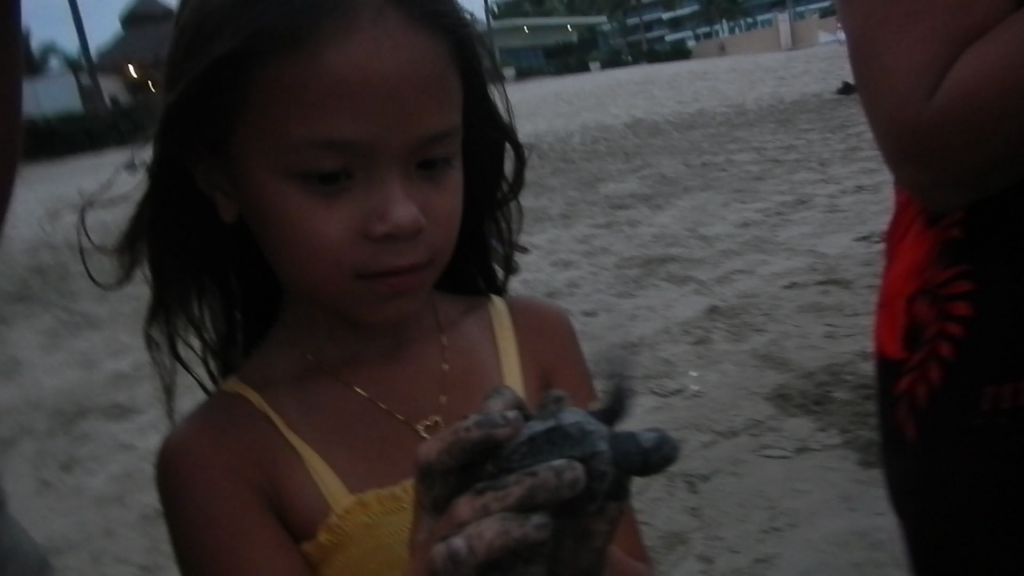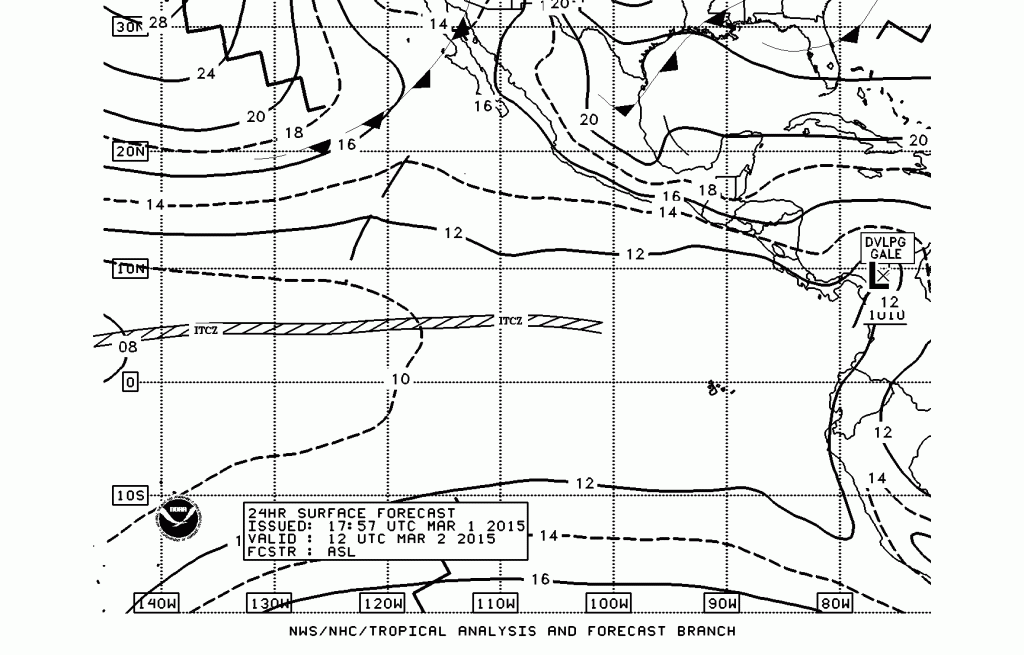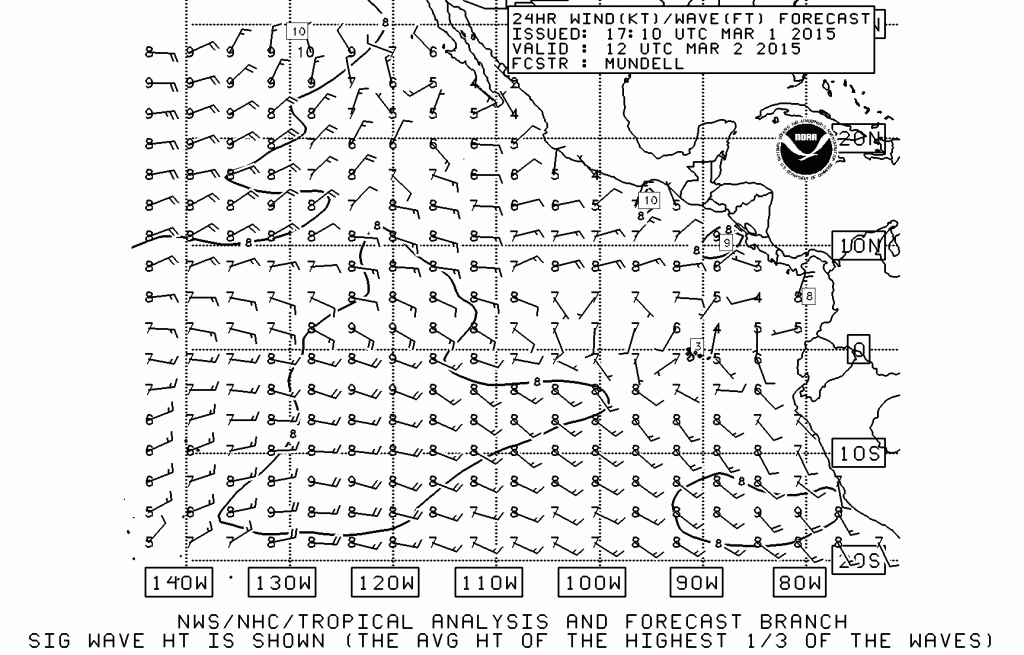[pin 4320] Our first update didnt post. I’m hoping this one will Day 5 Mar 24 Fish On!!!! Shortly after Jim;s shift started he saw a fish at the end of the line. It was a 20+lb yellowfin tuna. Of course this happens the day after we had a nice clean shower and there was blood all over Jim’s clothes and the deck of the boat. Nick miraculously didn’t get a drop of blood on him. We filleted the fish and froze half for later and ate sashimi for lunch and cracked pepper tuna steaks for dinner. It was amazingly tender and melt in your mouth and much tastier than skipjack tuna. The winds picked up today and we were on a beam reach and going fast. Way more rocky and rolly so cooking was a challenge as everything wants to roll away from me. Overnight Ian broke due to the strong wind & wave action so we’ve all got to hand steer overnight. A stainless steel bracket holding a pulley bent up (a lot of force considering this is 1/2 inch thick stainless steel). Day 6 Mar 25 We passed our 1/4 distance today! The winds slowed down today and Jim is worried that we’re going too far west so we’ve been trying hard to head more south. Today we put up our drifter sail – it’s like a large headsail but pretty like a spinnaker. It flew well in the light winds. Provisions wise the avocados and mangos are getting really ripe whilst the apples, oranges and potatoes are doing nicely. Since the winds were light, I did some clothes washing today. Mainly Jim’s blood stained clothes from yesterday and threw in some other clothes as well and set up the clothes line on the sunny side of the boat. We had tuna fried rice for lunch and leftover steaks for dinner. No more fish for a while. Overnight the wind died down to 4-5 knots and the sails were flapping and the boom banging so we turned on the motor for a few hours and headed south. We made water, charged up our batteries and turned off the engine when the wind picked up. Day 7 Mar 26 Everyone is tired as we have been hand steering for the last 2 days/nights. Also the sea has been confused which makes the boat roll up and down and side to side. The boom creaks, the sails flap and the blocks rattle whenever we get hit on the side by the waves as the wind is too light to keep the wind in the sail. It makes it difficult to sleep as well. So we’re more grumpy and irritable. We used the whisker pole on the head sail and it stopped the sail from slapping around. Jim is unhappy about our heading but we can only go where the wind takes us and maybe we should just head to Hawaii. The winds picked up steadily through the day but our heading is dead down wind and our boat doesn’t seem to want to head in that direction. Every day at 5pm we have a gathering in the cockpit for happy hour where we have a special treat and sometimes a beer or margarita. Today we had chocolate ice cream that I smuggled on board. We had cup of noodles for dinner. Day 8 Mar 27 Another tiring night of hand steering last night. Jim finally jibed and put out the mizzen sail to port and our poled out genoa to starboard on a wing on wing configuration, Ian was happy to steer the boat. Phew! We don’t have to hand steer tonight. Ian worked well, even with his dislocated shoulder in the 15-20 knot winds. The 2 cookbooks that I have found most useful is “The Boat Galley Cookbook” by Carolyn Shearlock & Jan Irons and “The Essential Galley Companion” by Amanda Swan-Neal. Today I made mango cream pie, thanks to Amanda who’s a kiwi (from New Zealand) as her book had 5 different mango recipes. As the oven was going to be on, I also made hamburger buns for our dinner tonight. It is challenging trying to cook with the rolly waves but I’m getting the hang of it. We had the mango pie for happy hour and Nick cooked up the hamburgers for dinner.
PV to Marquesas Days 1-4
[pin 4320] We’ve had such a pleasant stay in Mexico that it was sad to have the immigration and customs officials come to our boat to check us out of the country. We got our official “zarpe” which is the official document. Without this we’ve heard that it can tie your boat up with red tape at the next port of call in the next country. We’ve made many friends and had to say goodbye to some of them as our paths separate. We hope to meet up with them someday, at sea or on land. Flying Squirrel’s Dave & Amy and their kids Matthew & Morgan, who played minecraft with Jacintha are heading back up north doing the “Baja Bash” (sailing north up the Baja coast). We’ve had a few meals with Tom & Kelly and Sofie from Stochastic at the Vallarta yacht club (think cheese stuffed chicken wrapped with bacon) and for steaks at Sonora el Sur. They are also heading north. Yolo had Presley & Colton aboard and they had a few playdates with Jacintha. They are heading up the Sea of Cortez for the summer. Hannah on Ohanna is adventuring further south with her family towards Panama. Pelagic with Anna, Xander and Porter are currently in Panama awaiting their turn to transit the canal. We miss Billy and Gracie from Seahorse V and Bucket from Velvet Sky, they are south in El Salvador. We’re excited that Family Circus are also doing the Pacific Puddle Jump since Jacintha has so much fun playing with Amaia and Alina. They’re leaving a day later than us but will probably pass us along the way as their boat is faster – the advantages of having 2 hulls (catamaran). Korbut Rose will be crossing in April, we wish them good winds and hope to catch up with them in French Polynesia. Other boats on the puddle jump are Lorien, Daybreak, Sarita and Aussie Rules! Day 1, Mar 21, 122 nautical miles – We took off yesterday from Paradise Village heading towards another paradise. We were all chomping at the bit to leave (Jim most of all) but we had to have our last frappacino from Starbucks, McDonalds Happy Meal and Chinese take out lunch. After a couple of hours motoring, passing the dinghies of the regatta hosted by the Vallarta yacht club, we hoisted the sails and when we were just past Punta de Mita we turned off the engine and sailed. We had good wind with light seas. Perfect sailing weather. For dinner we had mushroom soup I had cooked the night before in anticipation of being seasick but the swells were minimal so I got to enjoy the meal as well. Our friend Lance has been sending us weather reports on our SSB email which is helping to determine which direction we have to sail. We were disappointed not to be able to hear the SSB radio net to see how many boats had left with this weather window including our friends. Overnight the sail was beautiful. 10 knots of wind with little swell. The stars were out and the lights from Puerto Vallarta grew dimmer and dimmer in the horizon behind us. Champagne sailing and the icing on the cake is that we’ve managed to tweak Ian (our Fleming wind vane) so he’s steering the boat perfectly on a beam reach, which means less work for us! Day 2 Mar 22, 140nm – Everyone except Jacintha was a little tired today but after a breakfast of chorizo omelette, mango and oranges, and naps for everyone, all is well. The fact we’re not hand steering makes a lot of difference in the exhaustion scale as well as having an extra person to take watch. Thank you Ian and Nick for being troopers. We sailed all day with all 4 sails up. A pod of dolphins swam by the boat this afternoon, jumping up and down around the bow of the boat. We also passed a couple of cargo ships and spoke to SV Kookaburra who were within VHF radio range but we didn’t see them. No bites on the fishing lines. On the SSB we found out our AIS tracker was interfering with our signal so we could communicate with the net tonight. We learnt that a bunch of boats took off the over the last few days. Day 3 Mar 23, 110nm – Today we had to head a bit more south to clear Isla Socorro. This meant that we were pointing further downwind and Ian did not like this point of sail as much. As the wind was lighter 8-10kts, it meant that there was not enough wind to steer our wind vane (he works on current and wind power). We took down the staysail and poled out the genoa which took a bit of effort. We had to hand steer a lot of the day. A flying fish visited our boat. It was tiny, about 2 inches long and had flown into the cockpit near Nick’s feet. We showed him the way back to the water. Jacintha has been super about being on the boat. She has been watching a lot of movies on the computer. High School the Musical 2 and the Lorax are her current favourites. Nick cooked pancakes this morning so she was very happy. Our batteries were running low today so we ran the generator to top them up. To conserve power we’ve turned off a lot of our electronics. This evening we instituted happy hour and had some margaritas with ice from the new freezer to celebrate. We had teriyaki chicken wings for dinner tonight. During night watch, I saw the Southern Cross low on the horizon. It’s such a comfort to me to see it and the pointers up there in the sky amongst the Milky Way. The moonless night makes the stars even brighter and I’ve been playing with Starwalk app on my ipad to show me the different constellations. Now all we have to do is bone up on our celestial navigation and dig out the sextant to find our latitude and longitude the old fashioned way. Day 4 Mar 24, 119nm – Today we passed to the South of Isla Socorro and headed more west again trying to catch the trade winds that we can see on our grib files (wind report). The winds were much lighter today and eventually we ran the motor for a couple of hours. We also made some water when the motor was running to fill up our drinking jugs. We are keeping a close eye on our fuel consumption as we only have what’s in the tanks (110 gallons left) and in our 2 jerry cans (10 gallons), so we have to be conservative. Having light winds is not fun as the boat tends to get swiped more by waves and rock and rolls sideways. Everthing swings and creaks, the sails flap and the boom rattles noisily. A bird decided to catch the bait on the fishing line trailing the boat and got it’s feet hooked. We had to pull it in and unhook it. We saw it take off after sitting in the water for a few minutes. We also took a solar shower on the deck this afternoon. It’s nice having clean hair and body and fresh clothes. Jim tried hailing any boats on the VHF but there aren’t any boats close by or they’ve turned off their radios. The SSB net at night is a social highlight for us as we find out where all the other boats are and what’s happened in their day.
Leaving Mexico for the South Pacific
It’s time to begin another chapter in our year-long cruise aboard Apropos. Tomorrow we are departing Mexico and heading for the South Pacific, where we expect to make landfall at Hiva Oa in the Marquesas. This passage typically takes about 3-1/2 weeks, during which time we will update the blog from sea.
Over 150 boats are part of the Pacific Puddle Jump this year. Some are leaving from Panama and others from various ports of Mexico. A large fleet is based here in Banderas Bay (Puerto Vallarta, La Cruz, Nuevo Vallarta) with 4 boats pulling out today and a few more leaving tomorrow with us. We will be keeping in touch with each other along the way via a SSB radio net that happens each morning for check-ins and weather reports.
We’ve had a lot of fun for 2 months in Puerto Vallarta and La Cruz. Its also been a lot of work getting Apropos ready for the crossing. During the past month, we had our coach-top decks re-caulked, had some welding done on the wind vane, re-did the control lines for the wind vane, finished the ratlines, had dinghy chaps made, fixed some leaks, re-stitched some canvas, scrubbed barnacles off the bottom, made canvas pockets for the cockpit, re-bed some leaking chainplates, and changed engine & transmission oil. Our final preparations for the crossing included filling the diesel and water tanks, provisioning, packing away the dinghy and finding a place to stow everything.
Many thanks to our family (mom and dad, Amanda) and friends (Lance and Carol, Marvalynn, Christy, Nick) who came to visit us in Mexico, bringing some of our favorite foods that can’t be found in Mexico, as well as the all important boat parts.
For the next month, we will update the blog from sea, and our DeLorme tracker will update our position every couple of hours.
We are sad to part ways with many boats we have become friends with during our 5 months in Mexico. Some are headed south to Central America, some are remaining in Mexico, some are going back to the states, and some are doing the puddle jump with us.
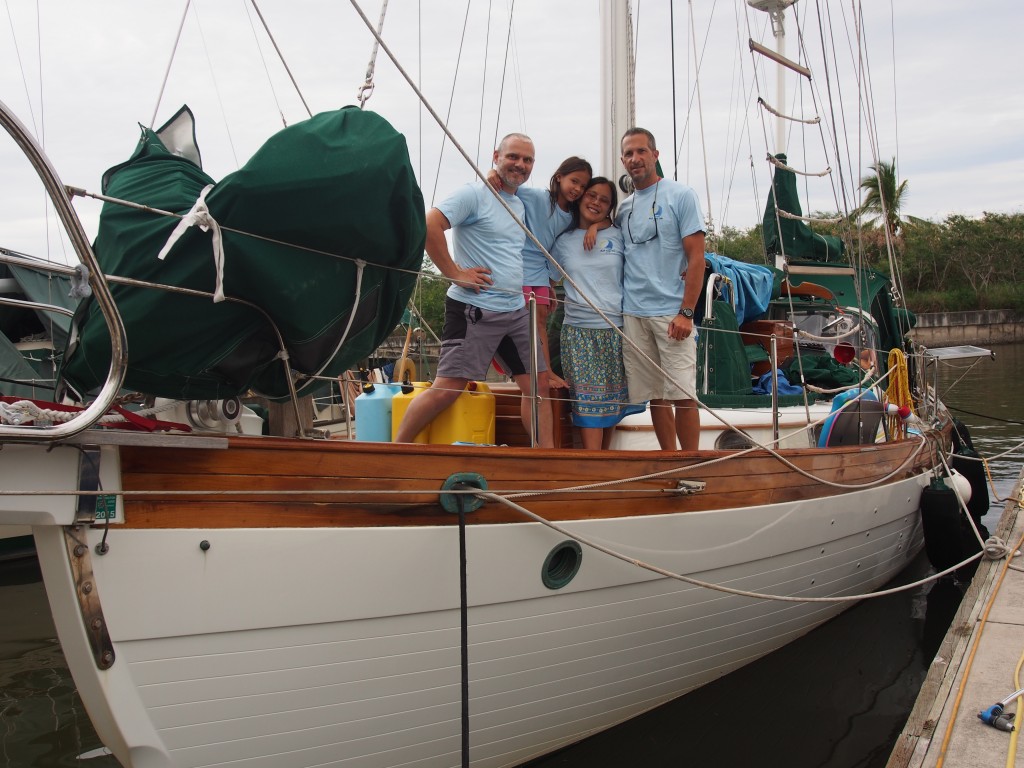
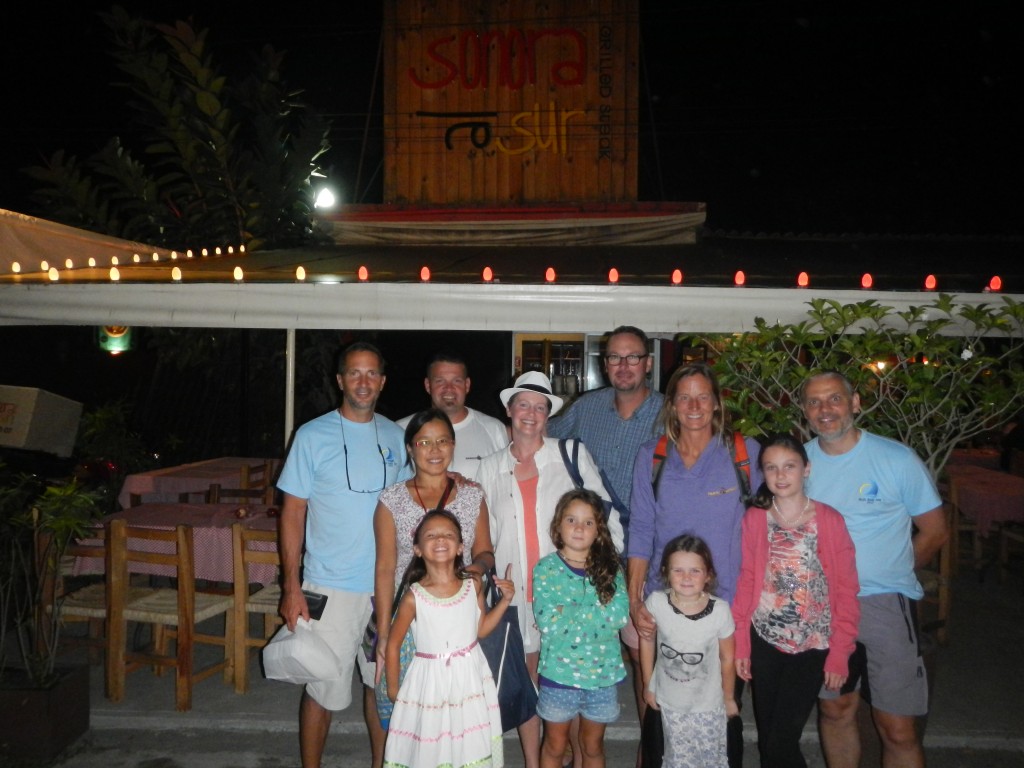
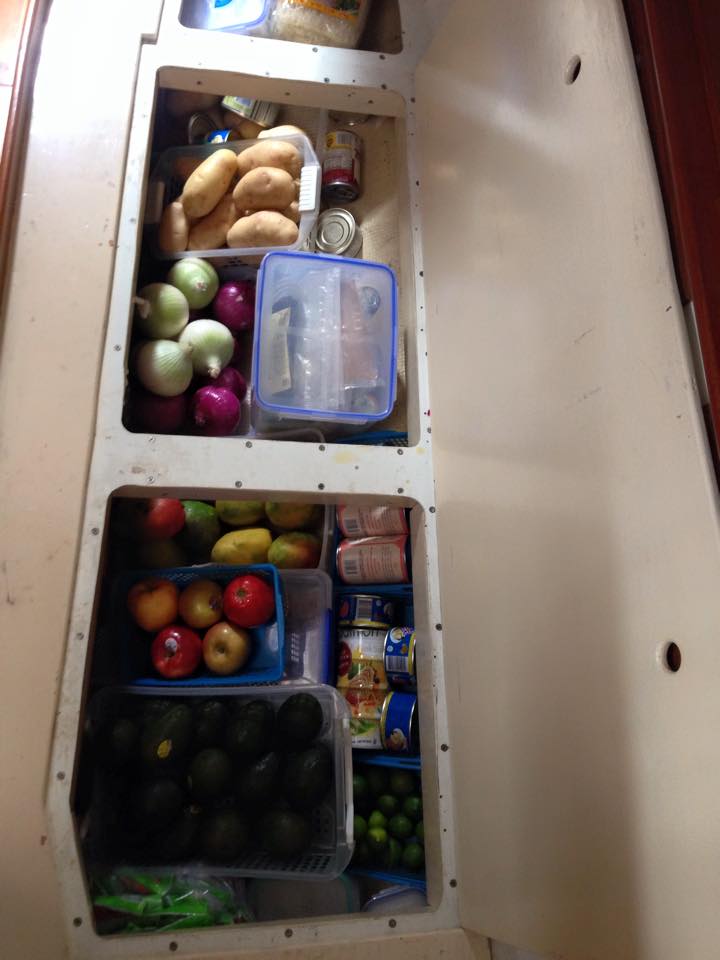
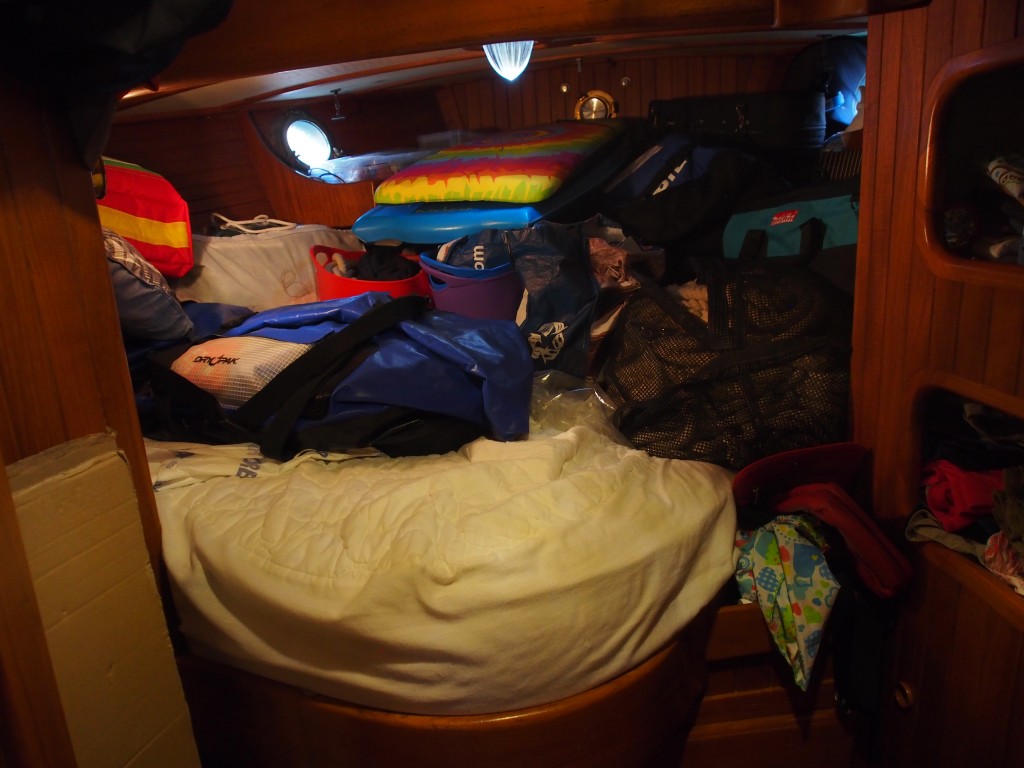
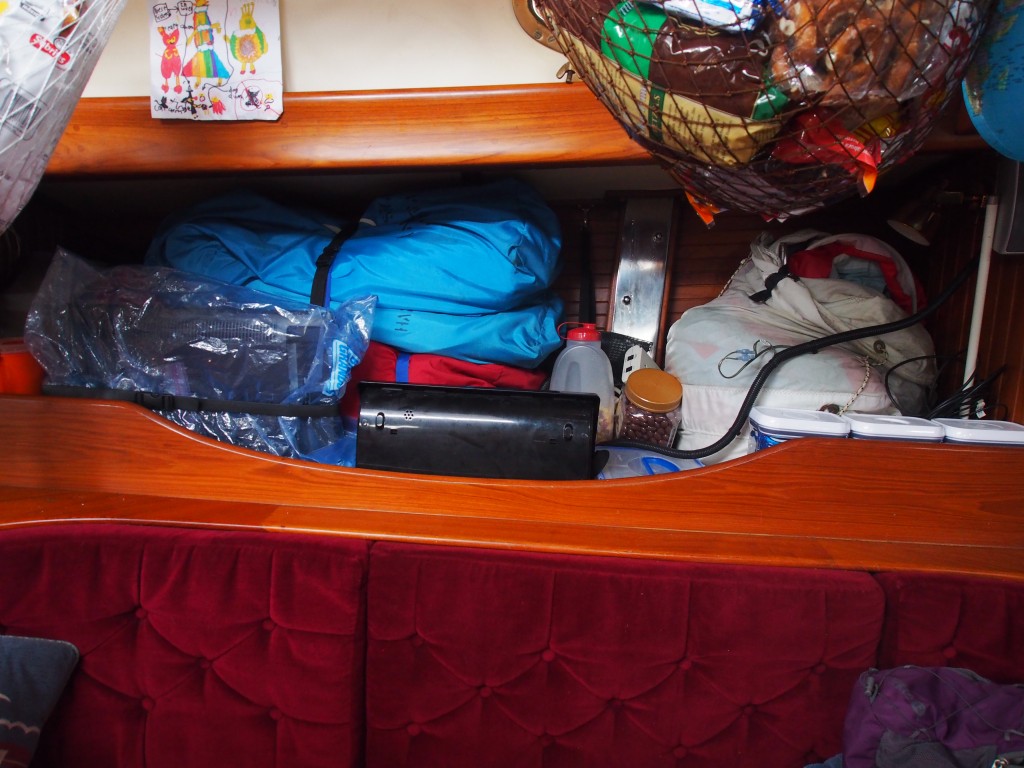
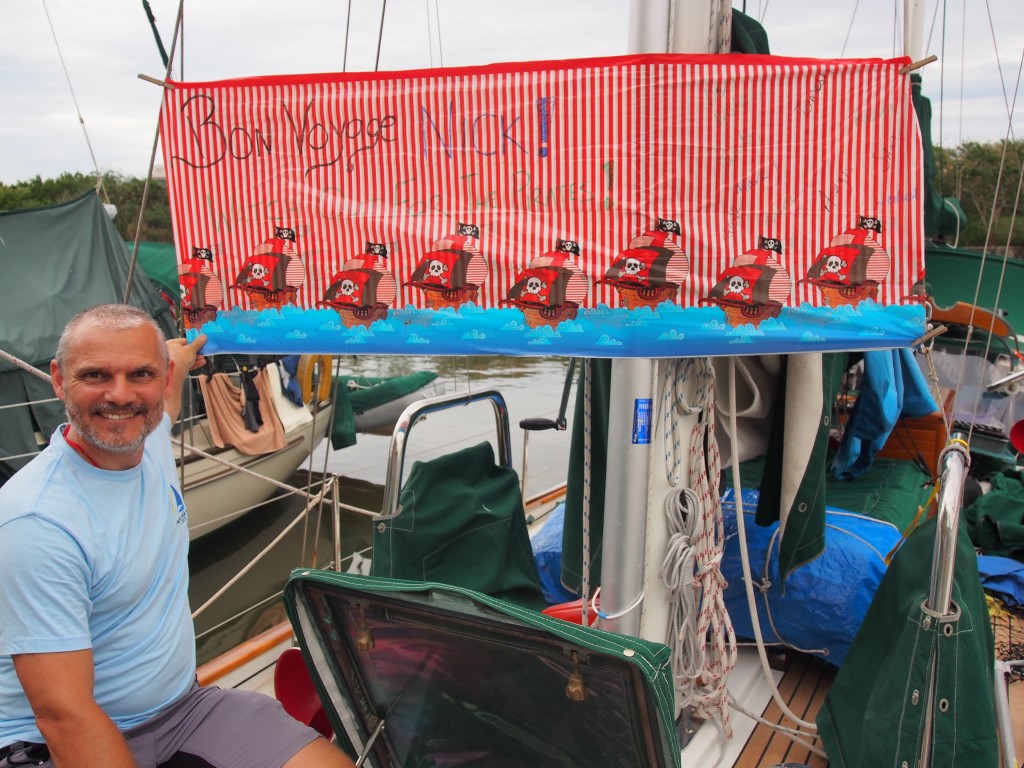
Puerto Vallarta–Nick Arrives
For our jump to the Marquesas, we decided that having 3 adults on board would be much better than 2. A 2-person watch can be exhausting especially in heavy weather, and since this crossing will take 3-4 weeks, it just made sense to have another crew member aboard. So, a few years ago we mentioned our cruising plan to Nick, who lives in England, and he was all for it. In fact, he was so gung ho that he contacted us in February 2014 to let us know he was all ready and was going purchase his airline ticket to meet us in Mexico. After we let him know he was a year early, he then had an entire year to really prepare!
So Nick flew from England to Mexico via California and arrived on March 7. He will be with us until April 26, when he flies out of Tahiti bound for New Zealand, then back to England.
While anchored in the bay near La Cruz, we’ve been tackling some final boat tasks during the day and going to live music in La Cruz at night. The local bands have some pretty amazing musicians playing 70’s, 80’s and 90’s music. One venue called Anna Banana’s had about a dozen leather Crown Royal whiskey pouches hanging from the ceiling that contained the ashes of former cruisers who hung out there. Another favorite was Gecko Rojo, so named when they were painting the walls red and a gecko happened to be on the wall and got painted. We watched a 2-person band at Ballena Blanco called The Traveling Band, who played amazing electric guitar to the beat of a mesmerizing bongo drum. Here’s an 8-minute video of her bongo solo: http://youtu.be/KZOu1qV-v2c
We’ve also been attending some of the cruising seminars that are put on at various marinas around Banderas Bay. Topics such as Medical, Electrical, Fishing, and Weather have all contained useful information as we prepare for the jump to the South Pacific.
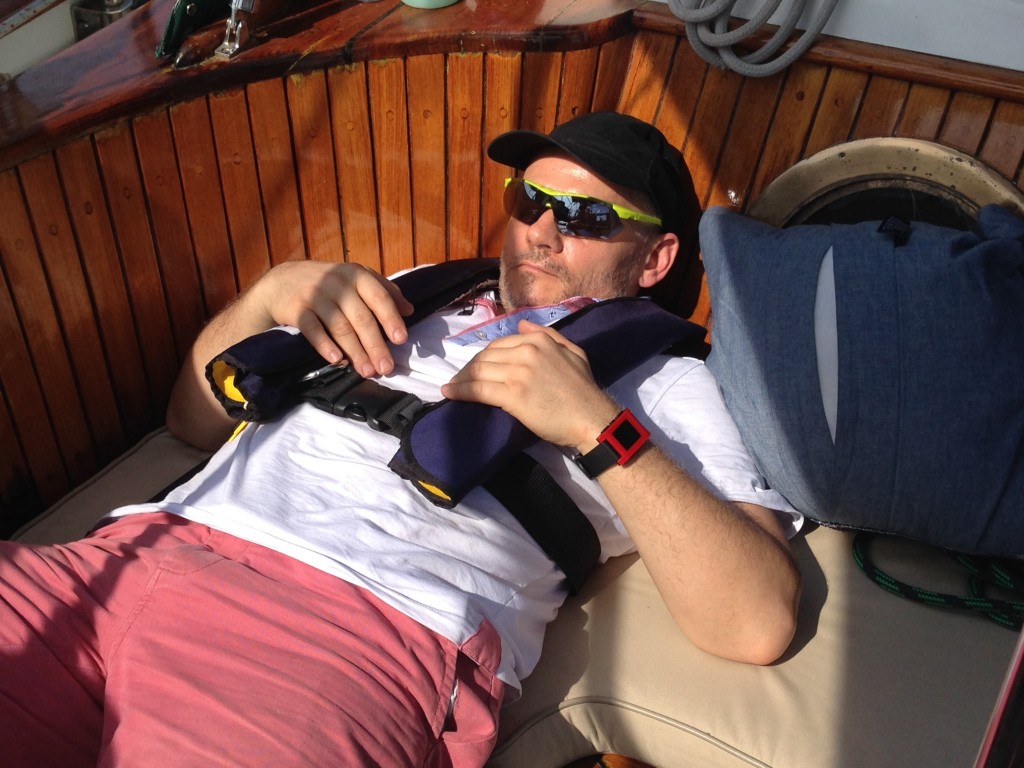
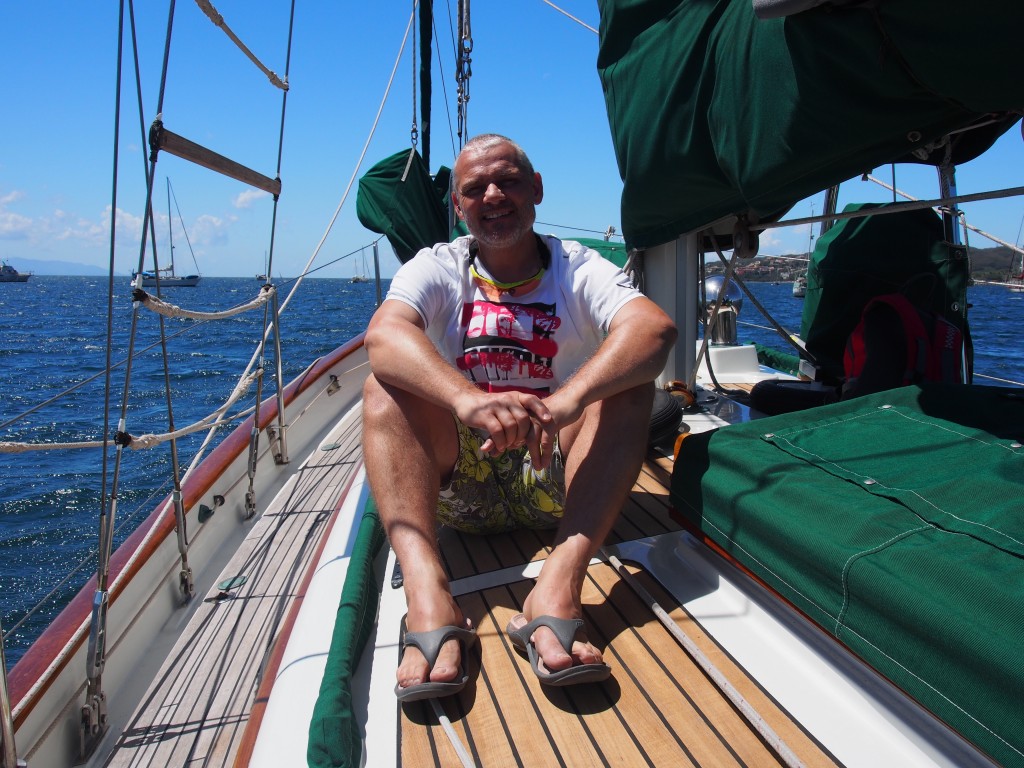
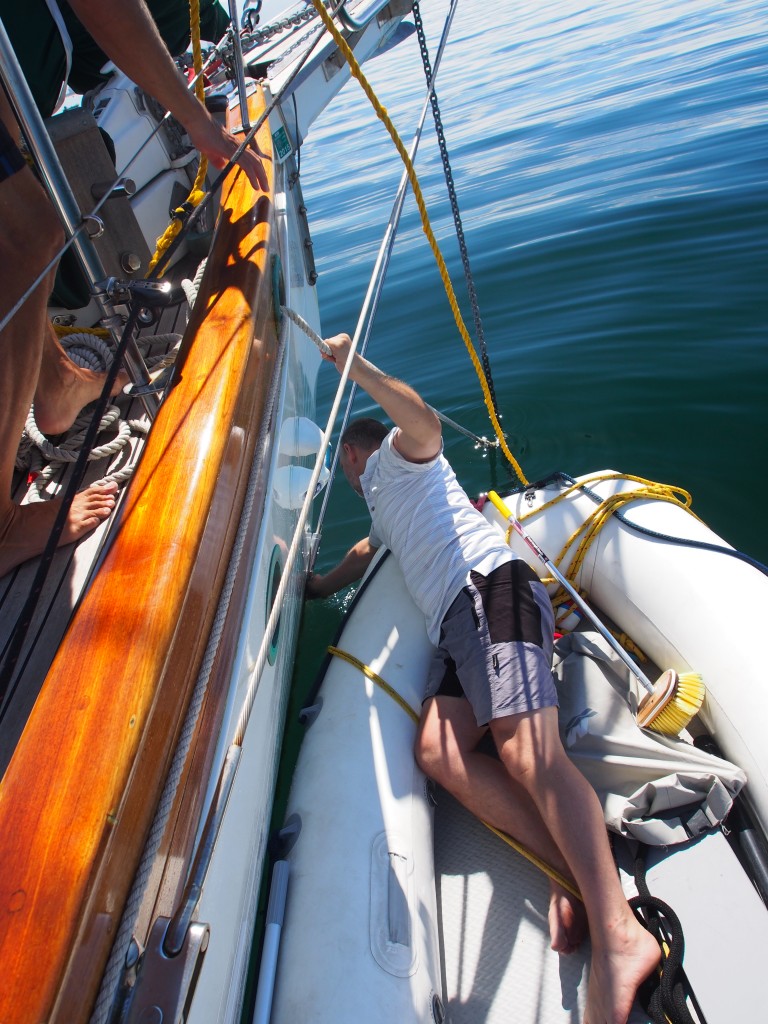
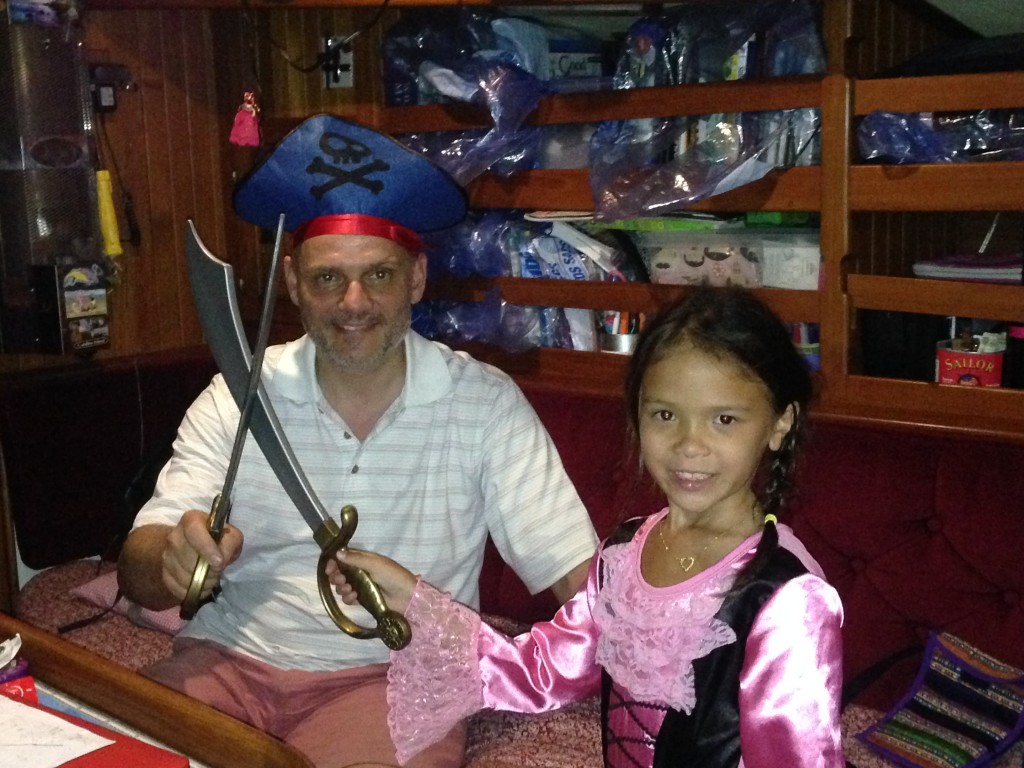
Baby Turtle Release II
We went to another turtle release that was held along the beach about a mile from Paradise Village. This one was a bit more relaxed compared to the one we went to in Zihuatanejo. After a brief and very informative talk by the volunteer coordinator, everyone in the group scrubbed all scent off their hands using the sand, then were handed a baby turtle. We got to hold it and give it a name, then place it in the wet sand 15 feet from the surf. It’s important that they make their own way to the surf, especially the females. While they are on land, they are using their senses to “map” the exact location using the earth’s magnetic fields, and the females will return to the same exact beach in about 7 years to deposit her eggs, just as her mother had done. It’s an amazing process and is why sea turtles have survived for millions of years, where many other creatures have become extinct.
YouTube video: http://youtu.be/XV9U_Sr3h78
Hangin’ in Puerto Vallarta waiting for Wind
A little about WEATHER
We’re still in Puerto Vallarta waiting for the right weather window to open up for the jump to the Marquesas. I attended a Puddle Jump weather seminar put on by Mike from PV Sailing and learned a lot. It’s looking like this year the jump window (prime time to depart from Mexico) will open up later than normal–around the 3rd week of March. We’ve been experiencing El Nino trends since 2012 where a band of warm sea surface temperatures develops in the central and east-central equatorial Pacific. This affects surface pressure in the southern hemisphere and sometimes means lighter trade winds in the south pacific.
We had hoped to leave around March 15, but will stick around until the weather gods give the go-ahead. It all has to do with the Pacific high stabilizing and moving into place so we can sail along the 1015 millibar barometric pressure line. When this happens, then you wait for a cold front to come down the outside of the Baja peninsula that will give you the push needed to reach the trades, which typically takes 4 good running days. If you leave at the wrong time, there will be too little wind and, unless you motor, you’ll be going nowhere fast.
So we’re keeping a close eye on the weather trends. The images shown below are part of what we look at. These are NOAA charts for a region of the Eastern Pacific and can be downloaded from the internet when land based, or from single sideband when at sea. The top one shows barometric pressure lines and the ITCZ (inter-tropical convergence zone ie doldrums) for today, March 1, 2015. Puerto Vallarta is at 20.7N, 105.3W, and we want to cross the equator near the 125 degree longitude line. The diagram shows a large part of the pacific sitting at a pressure of 12 (1012 millibar), meaning there would be very light winds.
The next diagram shows wind and wave height for the same region. The wind barbs point in the direction of the wind, and show the wind strength (each full barb represents 10 knots of wind, and half barbs are 5 knots, so the one in the top left is 20 knots, and the 3rd one down is 25 knots). The numbers next to the wind barbs represent average wave height (mostly 7-8 feet in the diagram). If you compare the 2 diagrams, you will notice that the higher wind occurs near the higher pressure gradients–in the upper left.
The diagram below indicates areas that are predicted to exceed 35 kt winds. It’s something we will look at every day during the crossing and we want it to look exactly like below–area void of high winds!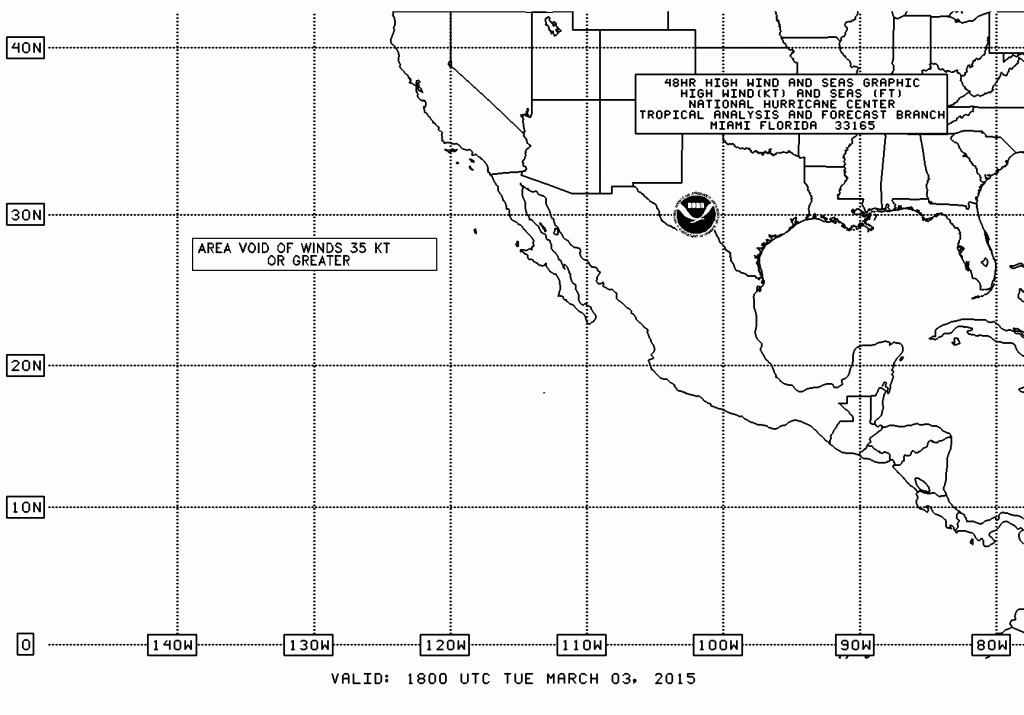
Puerto Vallarta–Carol and Lance’s Visit
Carol and Lance are friends of ours from Victoria, BC and fellow Hans Christian boat owners. They have a 38′ MkII and are liveaboards, so they felt right at home staying aboard Apropos for a week at Paradise Village marina. What started out as a request for them to bring us a few boat parts turned into a suite case ++ full of boat parts, special food requests, and some mail. They even made a trip to Seattle and picked up a huge order I put in at Fisheries Supply. Being in Mexico for 4 months makes you appreciate the selection (and price) of boating supplies in the US. It will get even more difficult in the South Pacific, which is why I stocked up on more spare parts….. Karen and I sorta went crazy with our requests though–peanut butter, cans of ravioli (for Jacintha), Cheerios, Snoqualmie Falls pancake mix, sewing machine needles, brackets for the SUP, more iPhone cables, an electric pump, spreader light bulbs, caulking, zincs, filters, tools, and more.
We spent the week enjoying the resort facilities–pools, yacht club & restaurants–and also accomplished a bunch of boat projects like finishing up some deck re-caulking, some work on Ian (Fleming wind vane), replacing spreader light bulbs, fixing a few leaks, canvas work, ratlines, etc. We attended a “Paradise Village Welcoming Party” that had free food, drinks, and entertainment–part of which Carol and I were participants. Carol volunteered herself and then me in some sort of dance contest where we made complete fools of ourselves dancing to 4 short songs of different genres (including disco and the song “What Does the Fox Say”)! But we were well rewarded with the winning prizes of Para-sailing (for Carol), a bottle of Tequila (for me), and a Mexican blanket (note–the audience was the judge and we had some friends in the audience)!!
During the week Karen, Jacintha, and I also went to the South Pacific Puddle Jump kickoff party that was held at the Puerto Vallarta yacht club. Andy from Latitude 38 Magazine (organizer of the Puddle Jump) presented a slide show and talked about what we can look forward to in French Polynesia. We also participated in some fun games with other fellow “jumpers” and Jacintha won a prize for getting up in front of everybody and telling a story–something about fishing in Australia. Each boat’s crew was interviewed for the Latitude 38 Magazine and a group photo was taken. It was a fun evening spent with around 40 other cruisers, most of whom we will meet up with in French Polynesia and beyond.
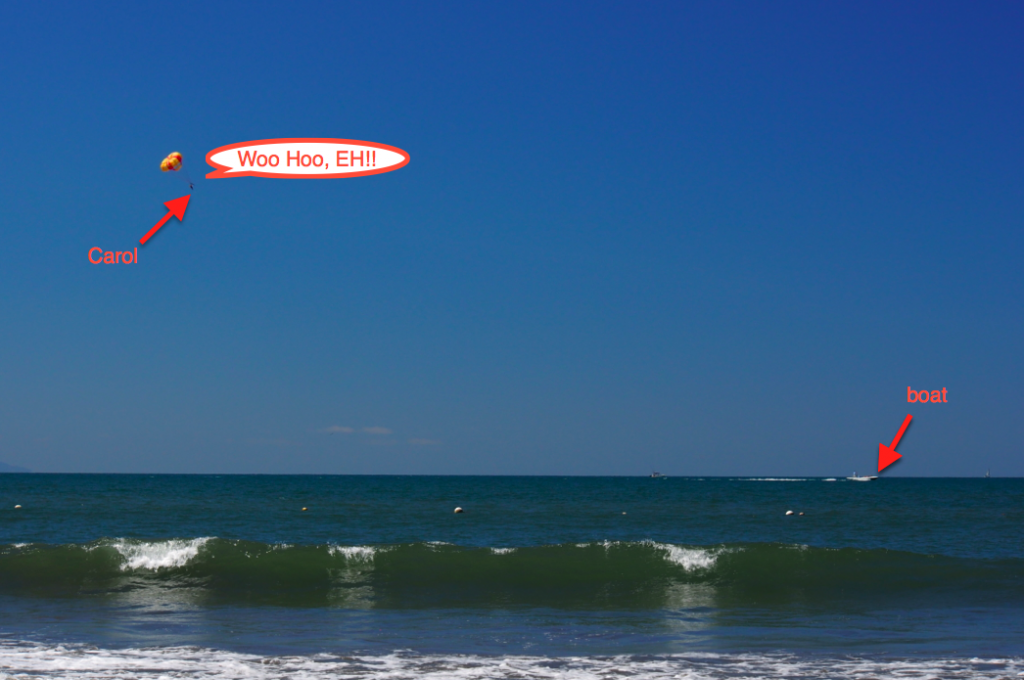
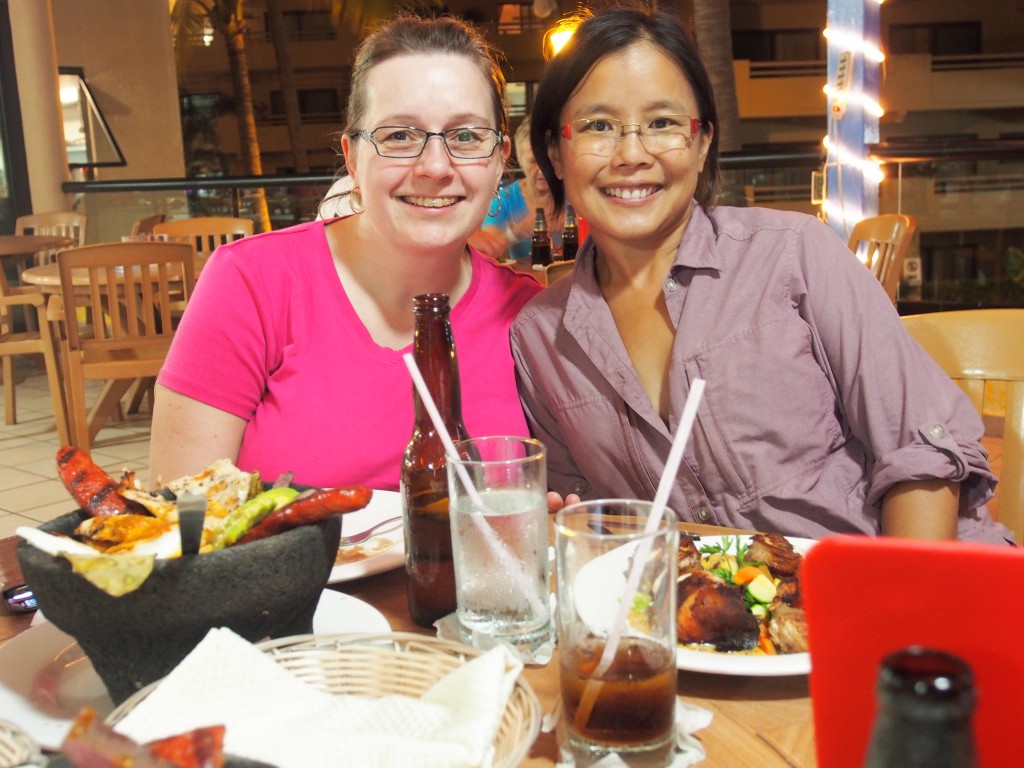
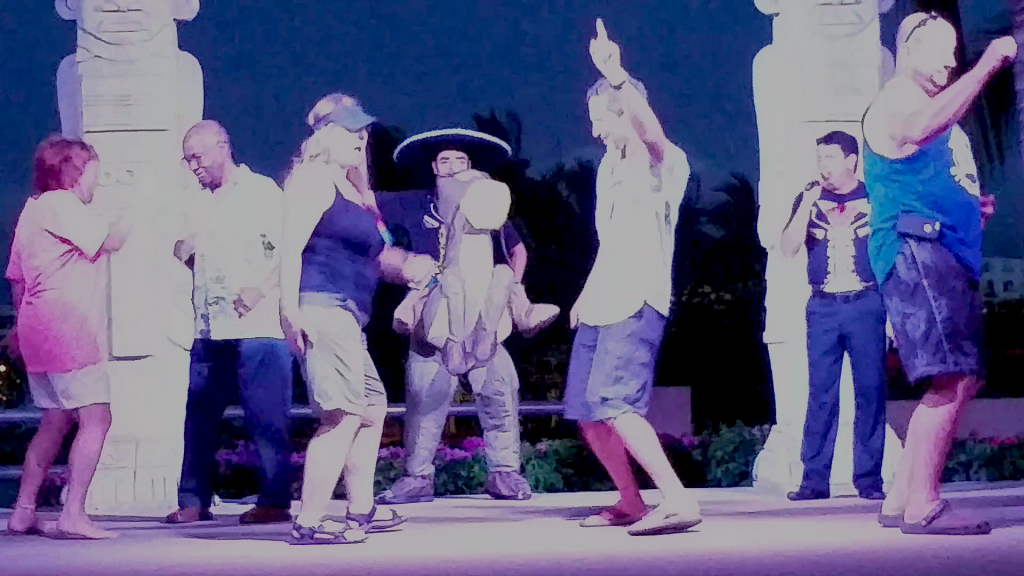
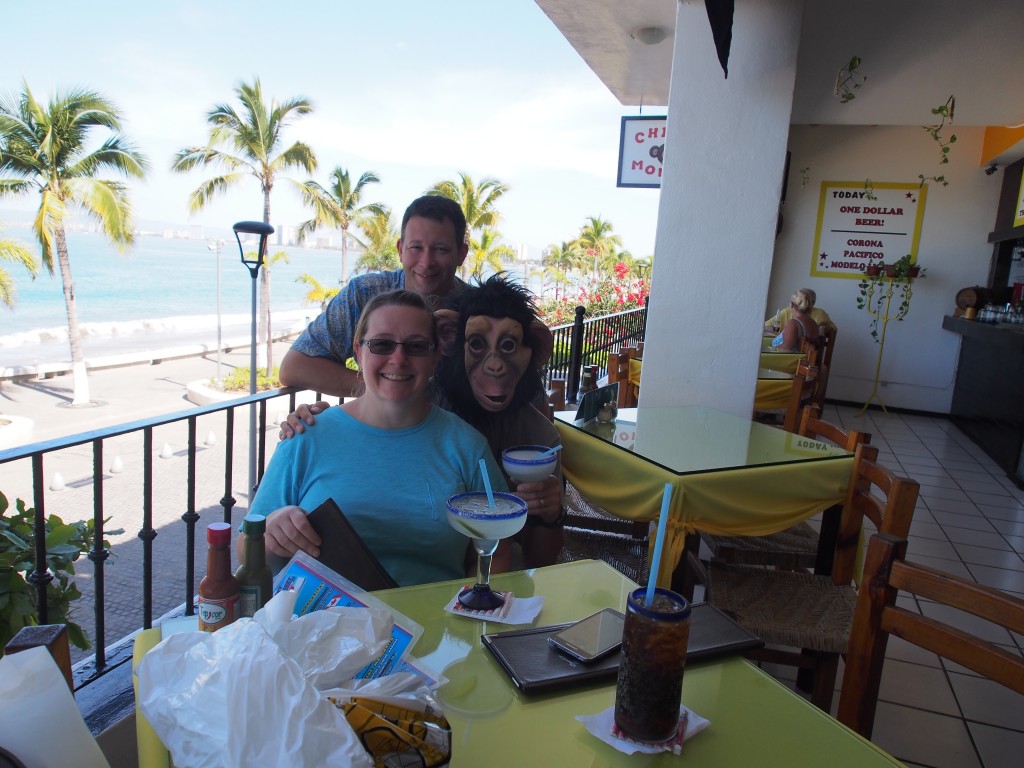
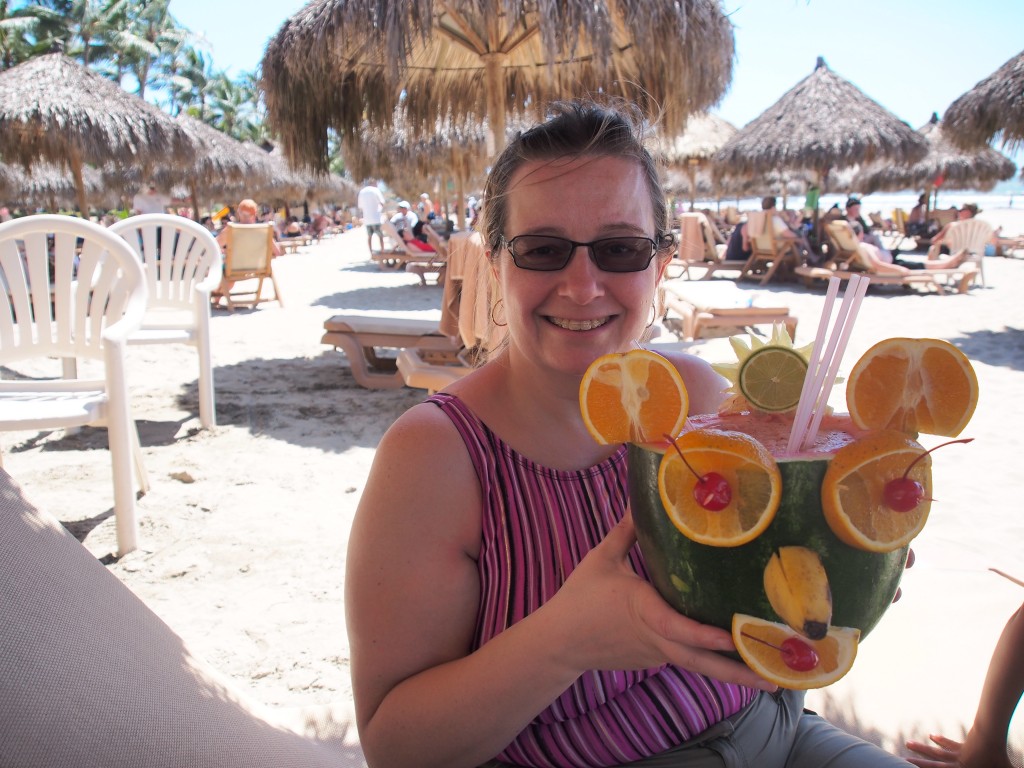
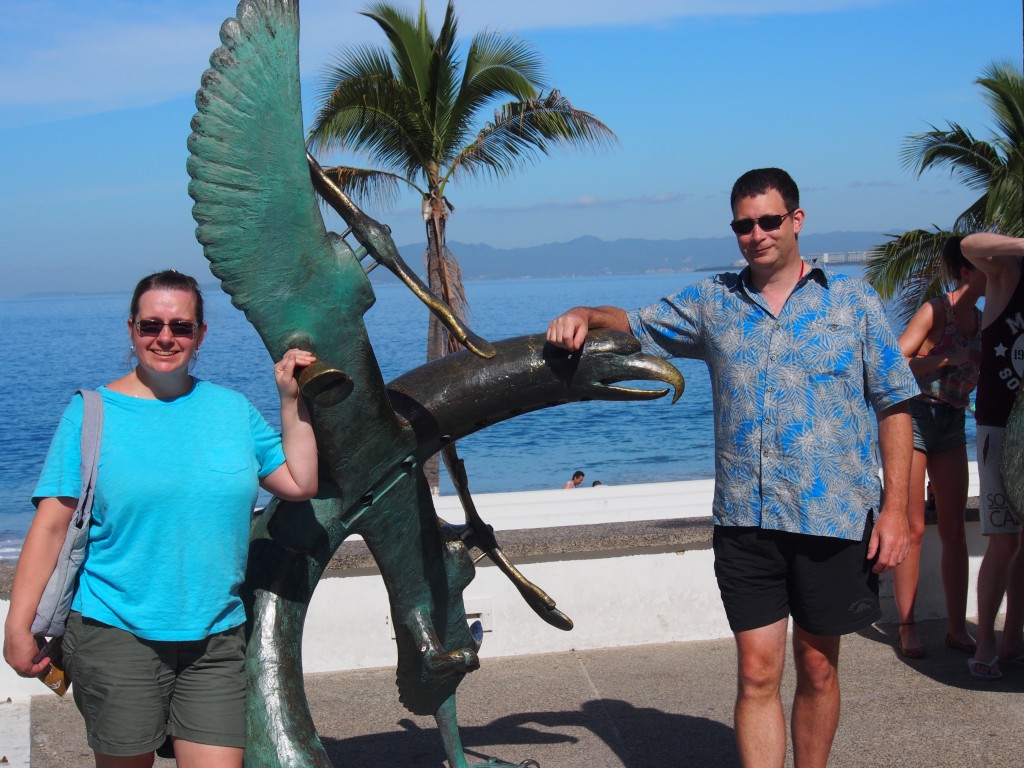
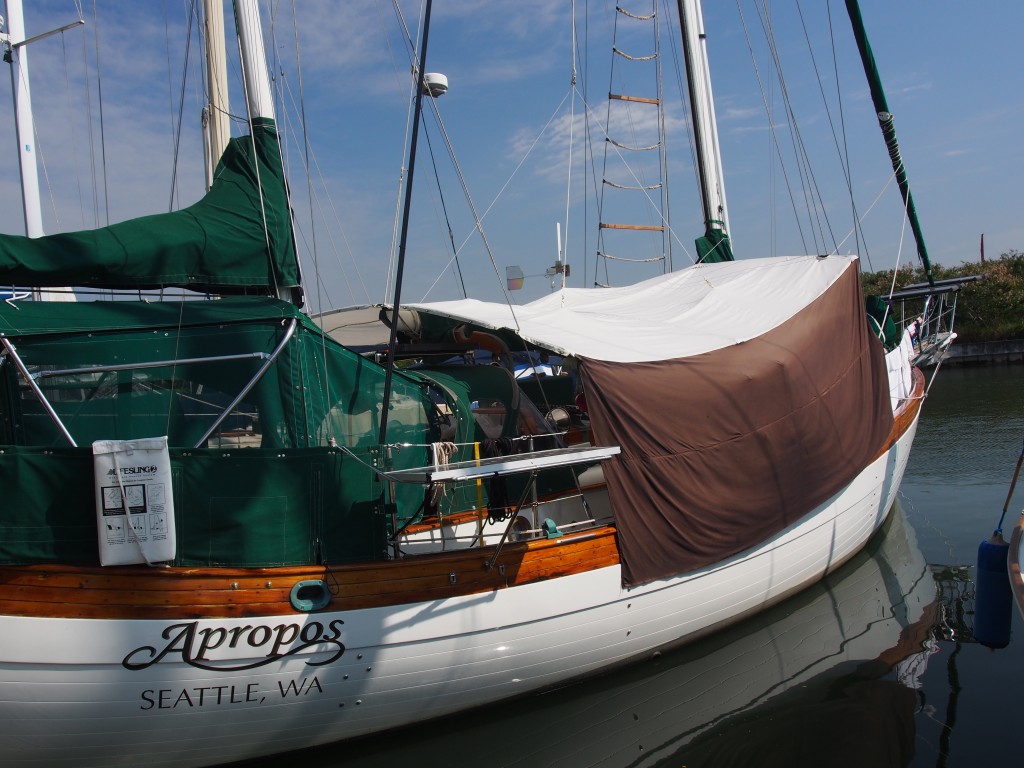
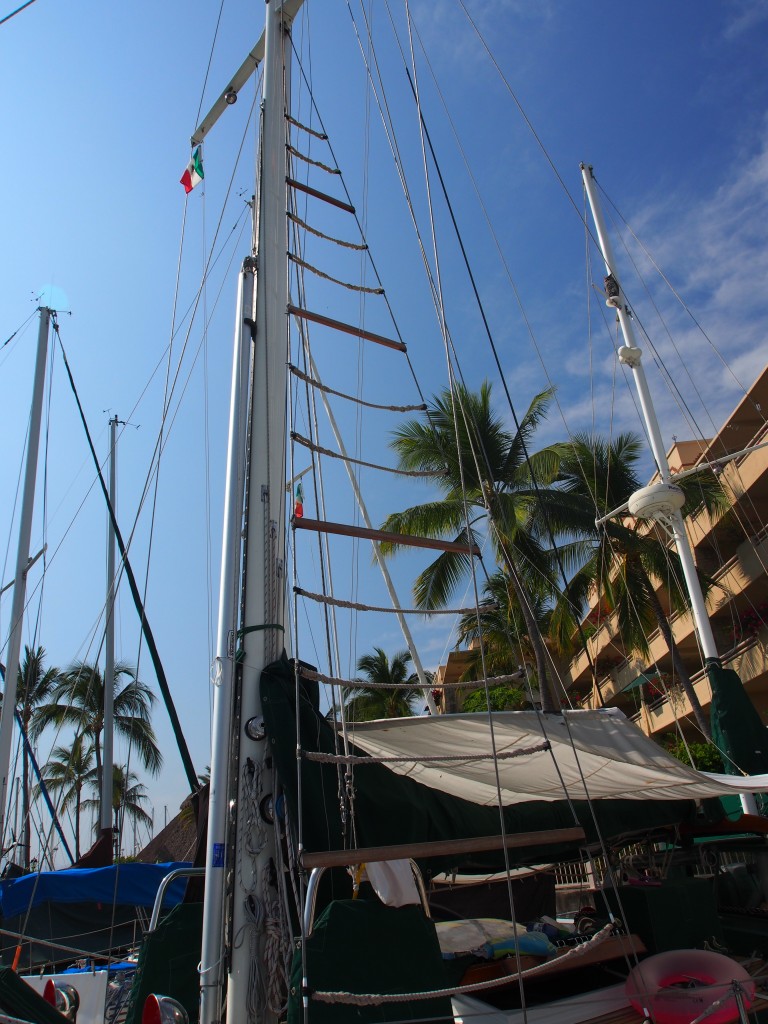
Puerto Vallarta–Amanda’s Visit
My 16 year-old daughter Amanda came for a visit during her mid-winter break from school, happy to leave the wet Pacific Northwest behind for a week. We hadn’t seen her for 6 months so it was great spending time with her.
During her stay, we visited old town Puerto Vallarta, hung out in the pools at Paradise Village, tried boogie boarding and stand-up paddle boarding in the ocean surf, and did a bit of sailing. Jacintha really enjoyed having her big sister around. As connectivity via wifi is paramount to a 16 year old, we also hung out at Starbucks in Paradise Village ALOT!
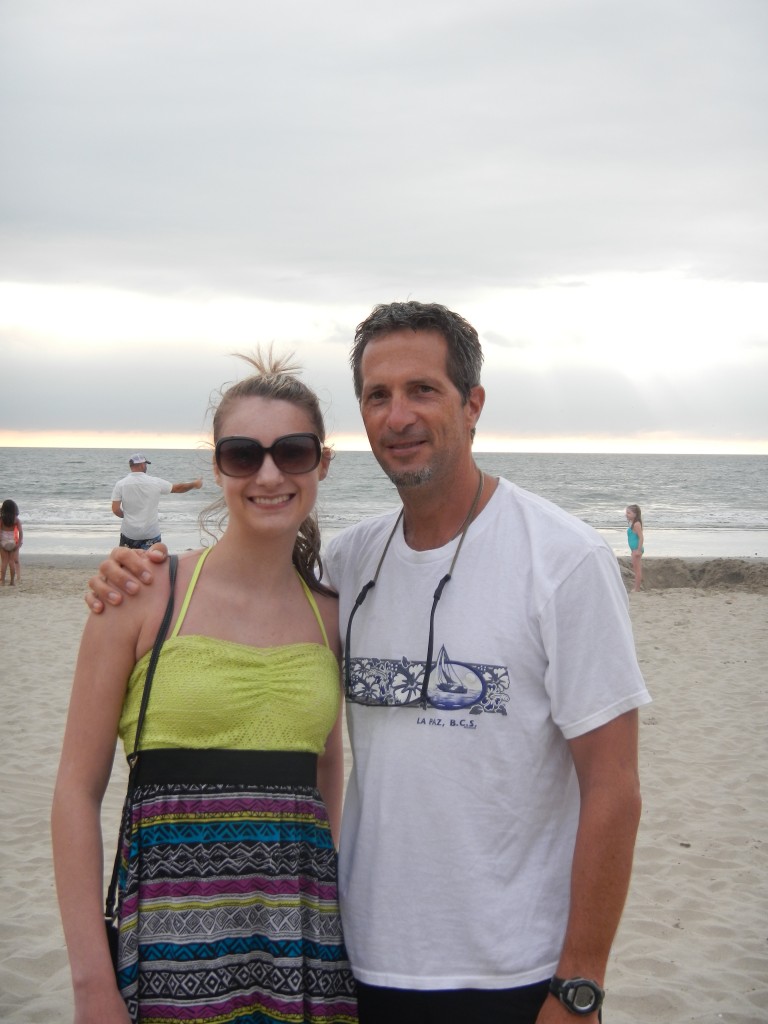
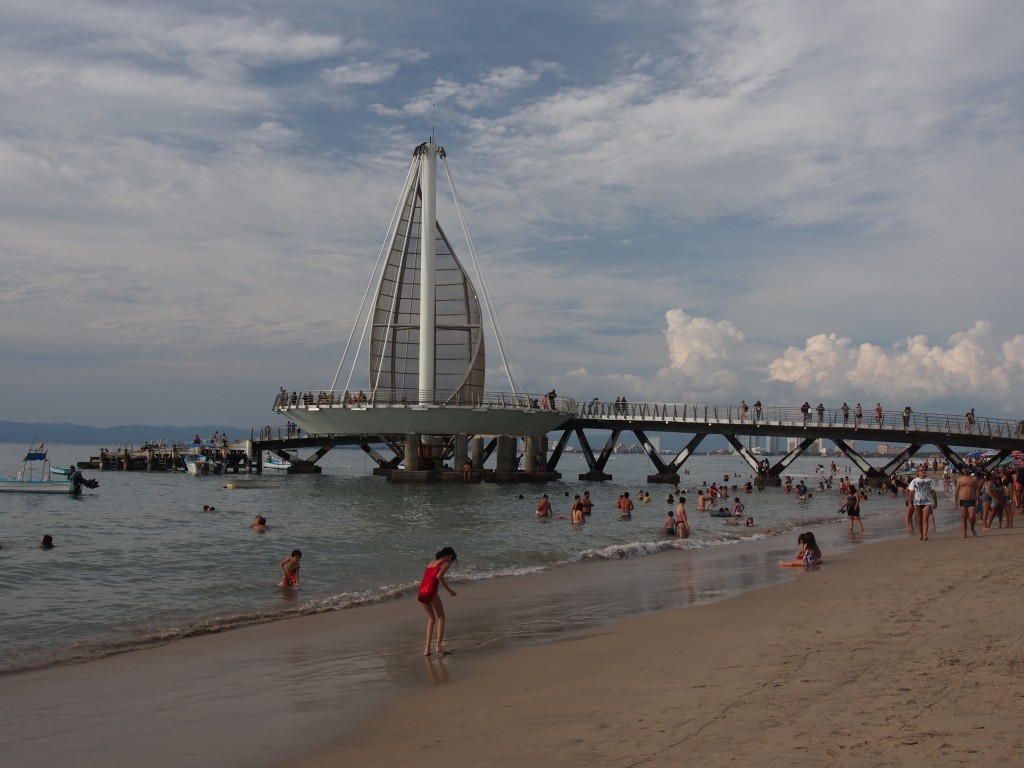
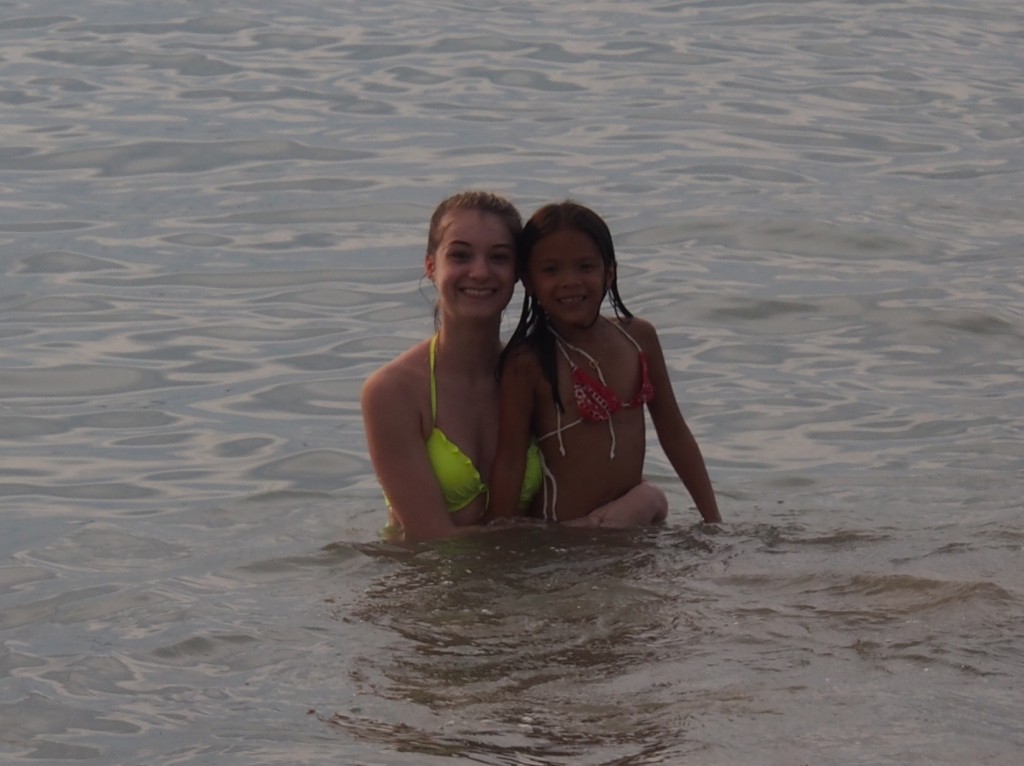
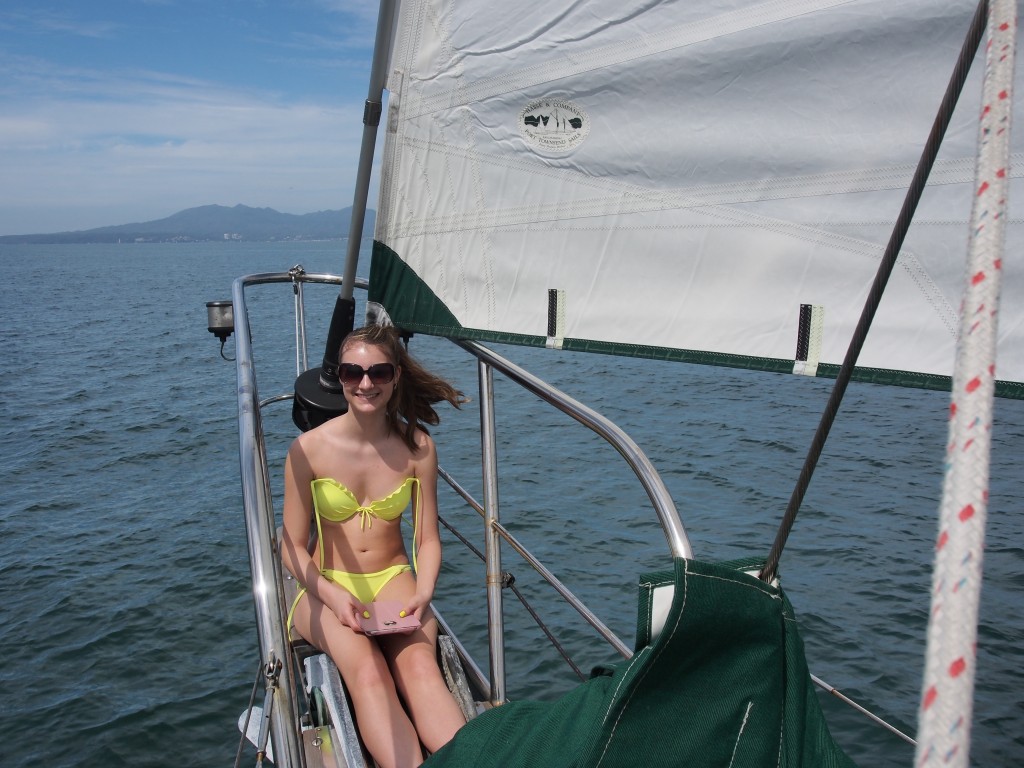
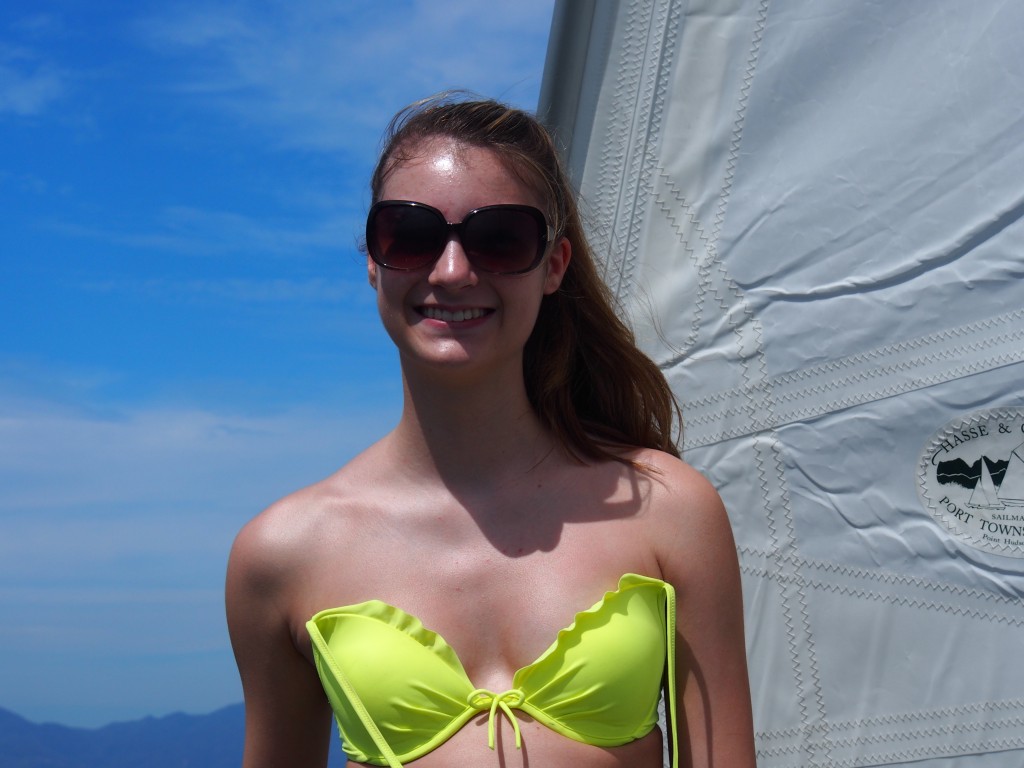
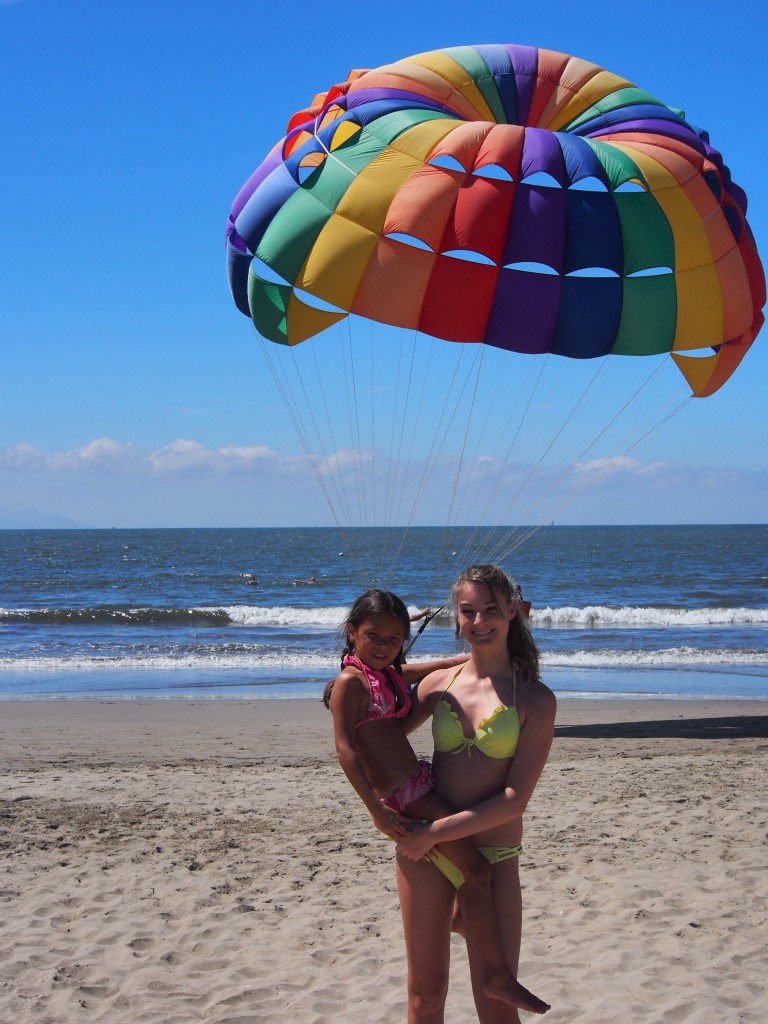
Teak Deck Re-Caulking
While at Marina Vallarta, we saw a lot of boat work being done to other boats on our dock, so I asked around and found someone who does teak deck work. Apropos has all-teak decks and most of it is in good shape for a 33 year-old boat. Built in Taiwan in 1982 when quality teak was in good supply and relatively inexpensive, the teak decks on Apropos still have plenty of thickness, thanks in part to not using a course bristle brush to scrub them. Much of the teak caulking had been re-done during the refit in 2004 and is still in good condition, but all the panels on the coach-top still had the original caulk and showed signs of cracking with age.
I hired Misha, who makes a living taking care of large yachts for their owners, to re-caulk all the deck panels on the coach-top. We agreed on an hourly rate (about 1/4th what it would cost back in Seattle) and he said he could start immediately. He didn’t mind if I helped and I soon became an apprentice working alongside him for 3-1/2 days. After removing deck hardware, deck boxes, the traveler, and anything else in the way, we began by removing the old caulk. This is very labor intensive and involves using a utility knife to score both sides of the channel of caulk along the teak. The channel is U-shaped and about 1/4″ deep, so a small amount of pressure is applied. The caulking can then be removed using a handmade tool to help pull out the caulk. Long strips can be removed by gently pulling on the caulk while using the tool to scape along the bottom of the channel. The tool, similar to a reefing hook, was made from a flat screwdriver that was heated, bent, then shaped to a tapered point. I ended up doing the majority of the caulk removal job while Misha followed with hand-sanding the channel to remove any leftover caulk for better adhesion of the new caulk, and masking the seams with blue 3M tape. As I got more efficient, I would have another panel ready by the time Misha finished masking a panel http://blogs.asburyseminary.edu/blog/cialis-online.html.
There are 2 methods for re-caulking. One is to mask only around the outside edge of the panel (where the fiberglass gel coat is), then apply the caulking (Teak Decking System SIS 440) to the channel and smooth it out with a putty knife. After the caulking dries and cures in 48 hours, some of the excess caulking is cut away with a razor knife and then the entire panel is sanded until only the caulk in the channel remains. The disadvantage of this method is that some of the teak gets sanded away. The advantage is, as long as the teak is thick enough, it removes the ridges in old teak and leaves it nice and flat. I decided to test this method on 3 of the small panels towards the bow.
The second method is what we ended up using on the majority of the teak panels. It involves masking every seam so that only the channel is exposed, then applying the caulking and smoothing it with a putty knife. After the caulking cures, the tape is carefully removed and the panel is sanded. I did the masking of a few of the panels and realized how painstakingly a job it was, especially going around curves! The extra time spent masking the teak in this method is about equal to the amount of time spent removing all the excess caulking in the other method. But in the end, I believe masking every seam is the better approach http://enligneviagr...
After 3-1/2 days of hard labor and 22 tubes of caulk, the job was completed. The coach-top panels are much smoother and the caulking came out great. The final step was to re-bed all the hardware, deck boxes, and traveler back in place.
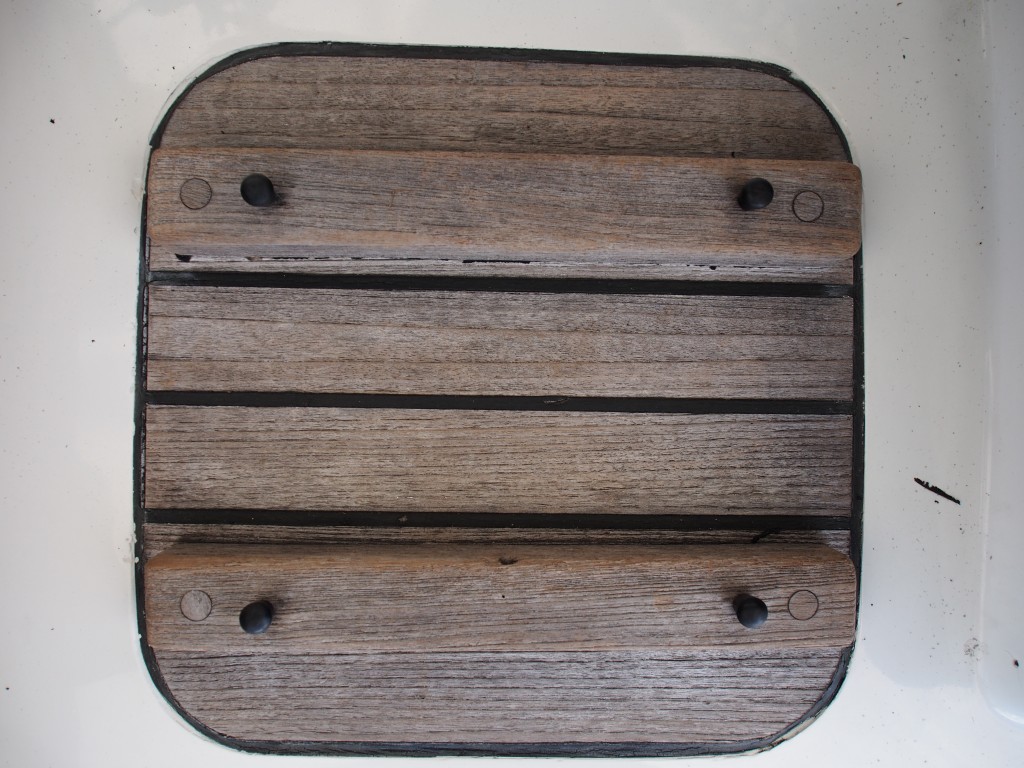
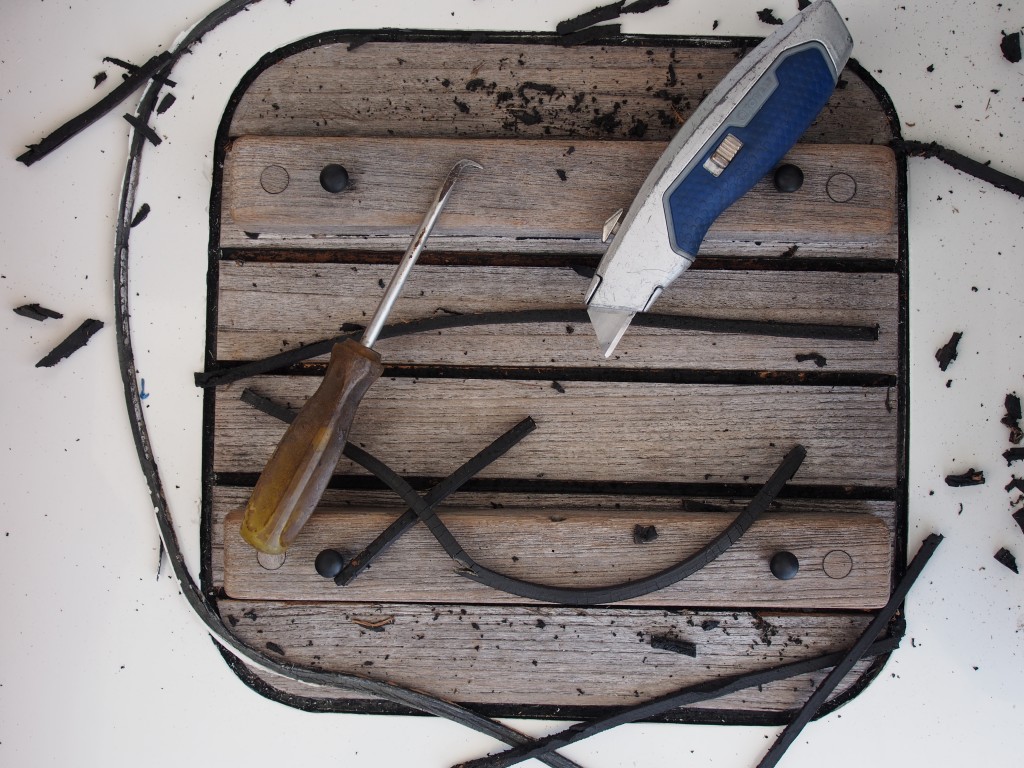
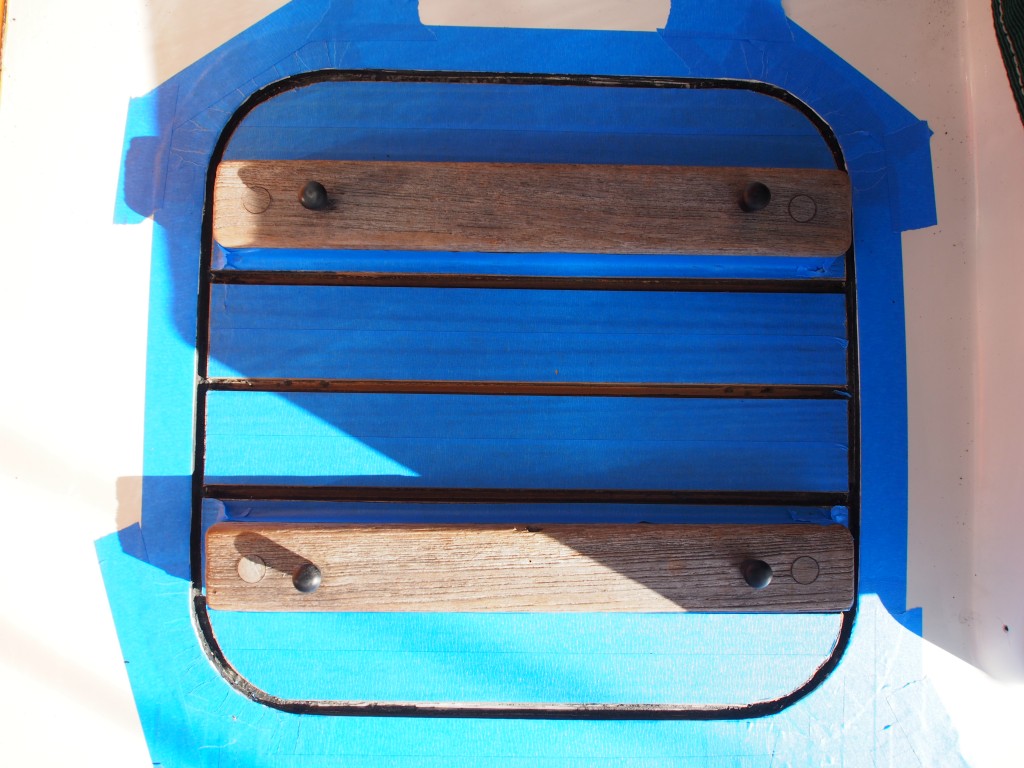
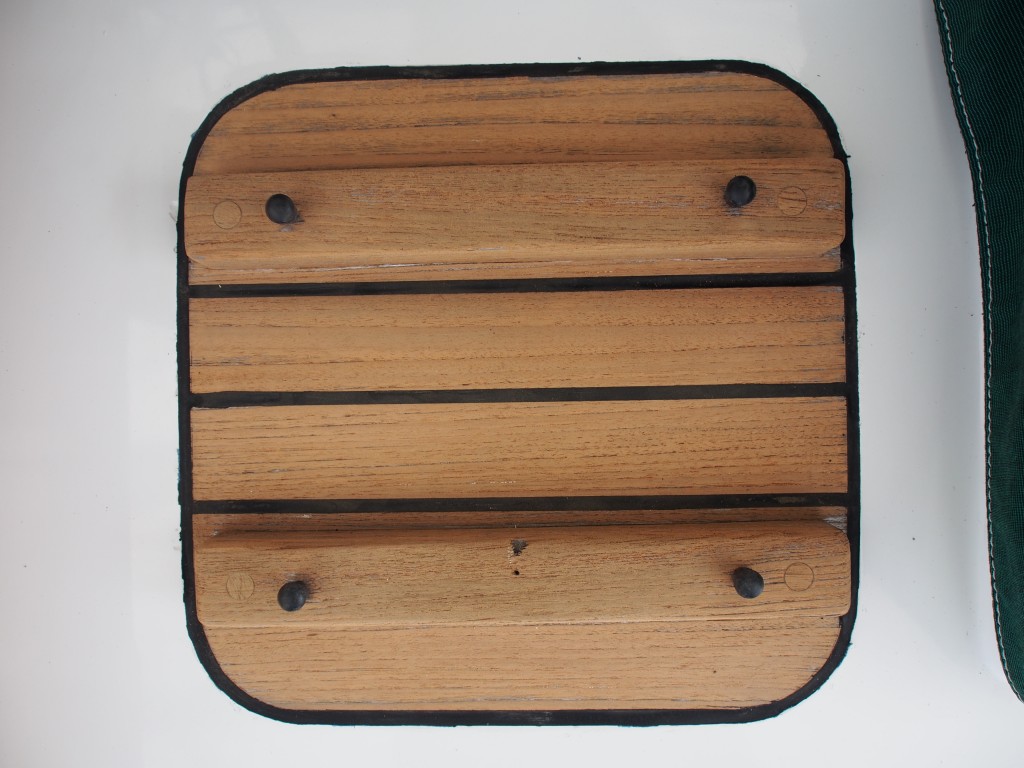
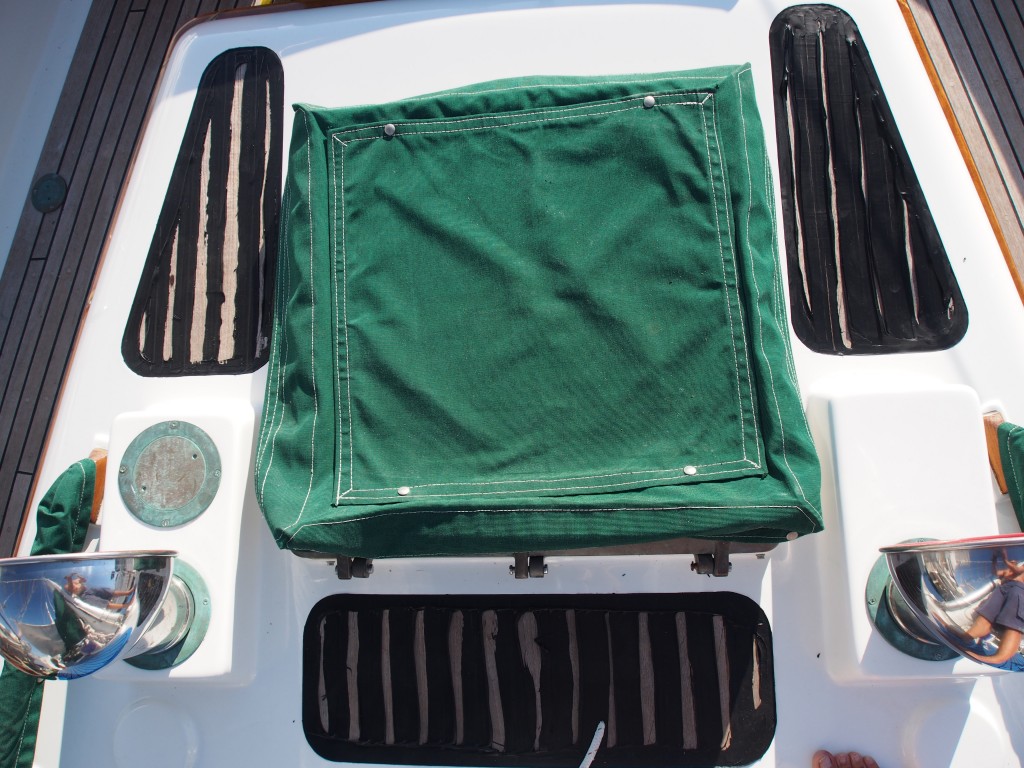
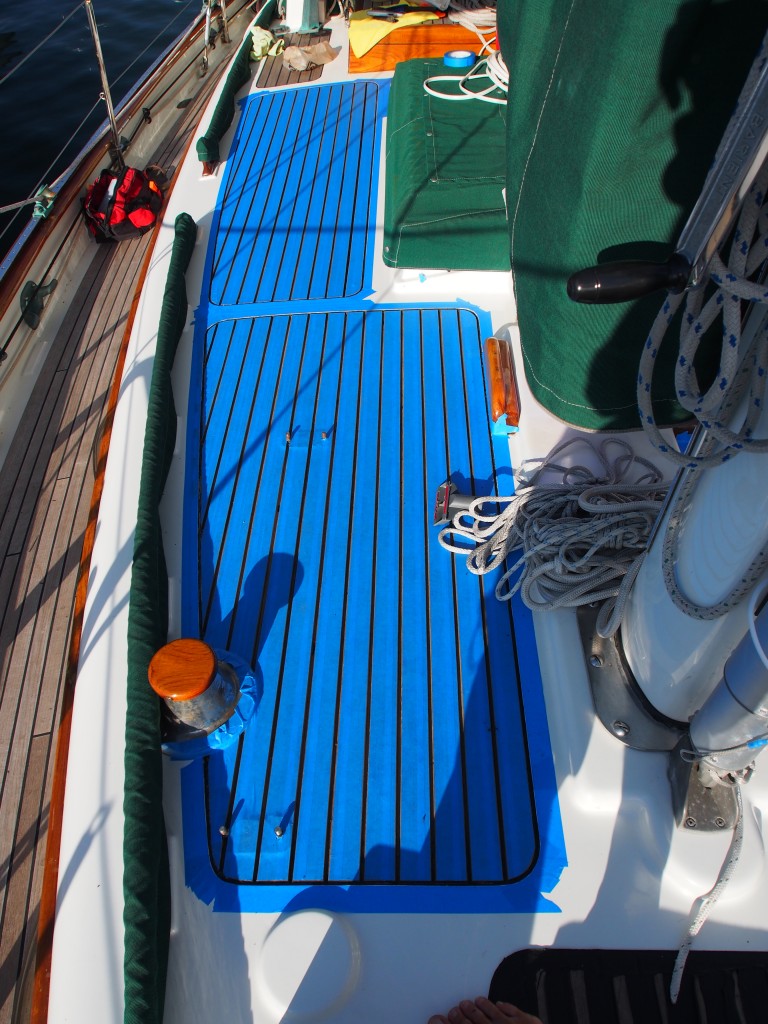
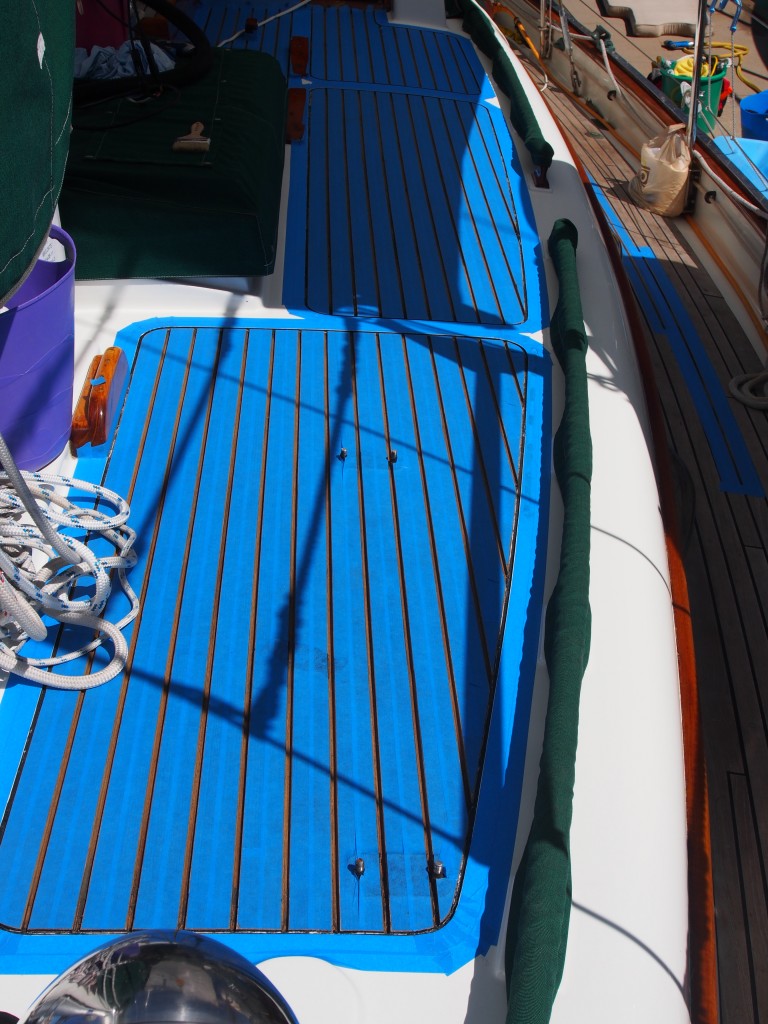
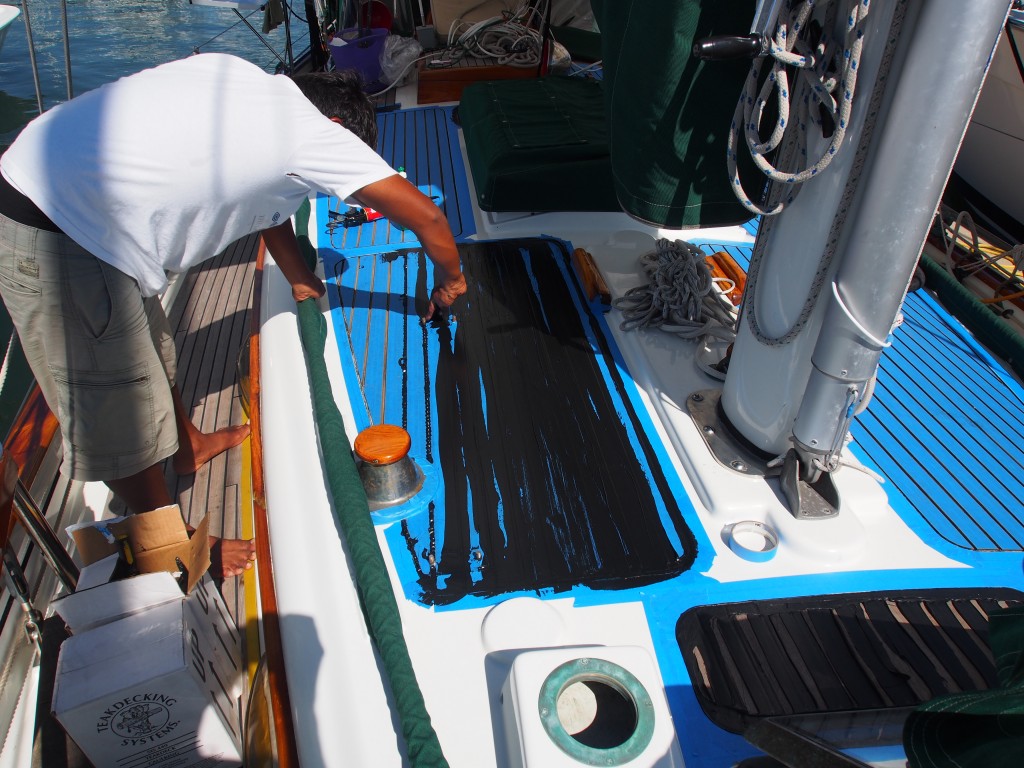
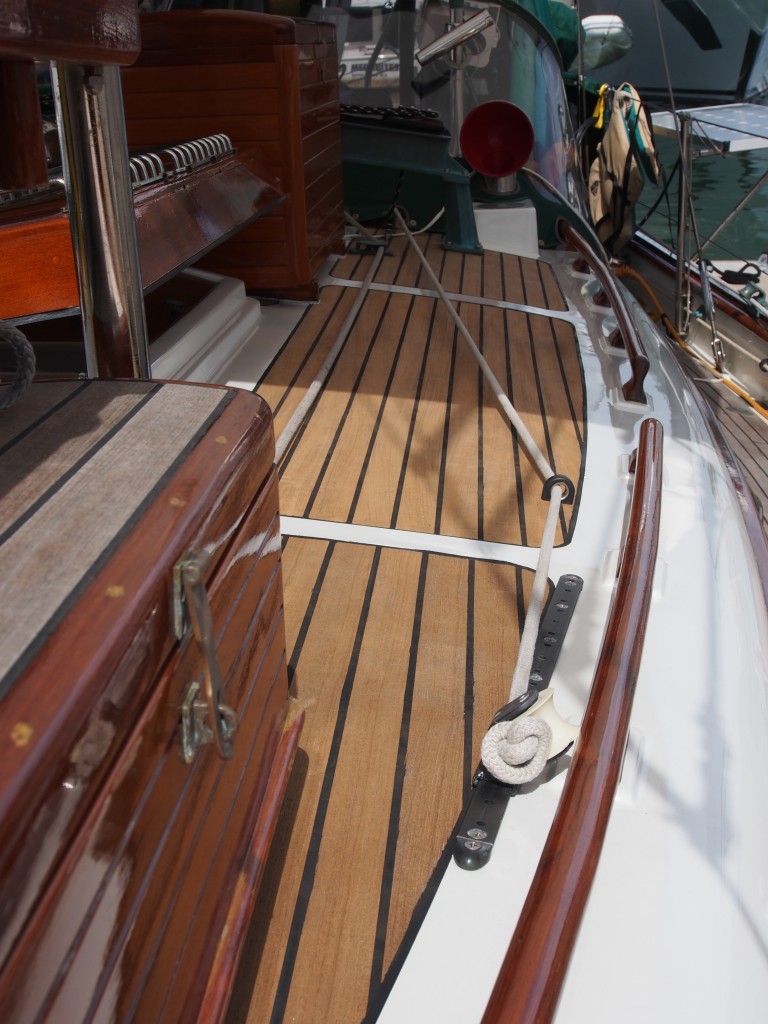
Puerto Vallarta–Mom and Dad’s Visit
It’s been awhile since our last blog update, but we’ve been keeping busy in Puerto Vallarta for the past 2 weeks.
My parents flew in for a 5-day visit, staying at the Westin resort which was a 15 minute walk from where we kept the boat at Marina Vallarta. We spent most days relaxing at the Westin pool and most evenings at different restaurants along the marina. It was their first visit to Mexico, but they didn’t really come to see the sights, just to relax and spend time with us before we leave for the South Pacific why not try this out. Besides a bag full of boat parts, they brought with them some things from Pennsylvania–deer bologna/pepperoni thanks to my sister & brother-in-law, and my dad’s home-made sauer kraut.
We also completed some boat tasks during the past 2 weeks. The biggest project was having the teak decks on the coach-top re-caulked (more details will be provided in a separate post). I also did some work on the windvane and Karen finished some sewing projects.
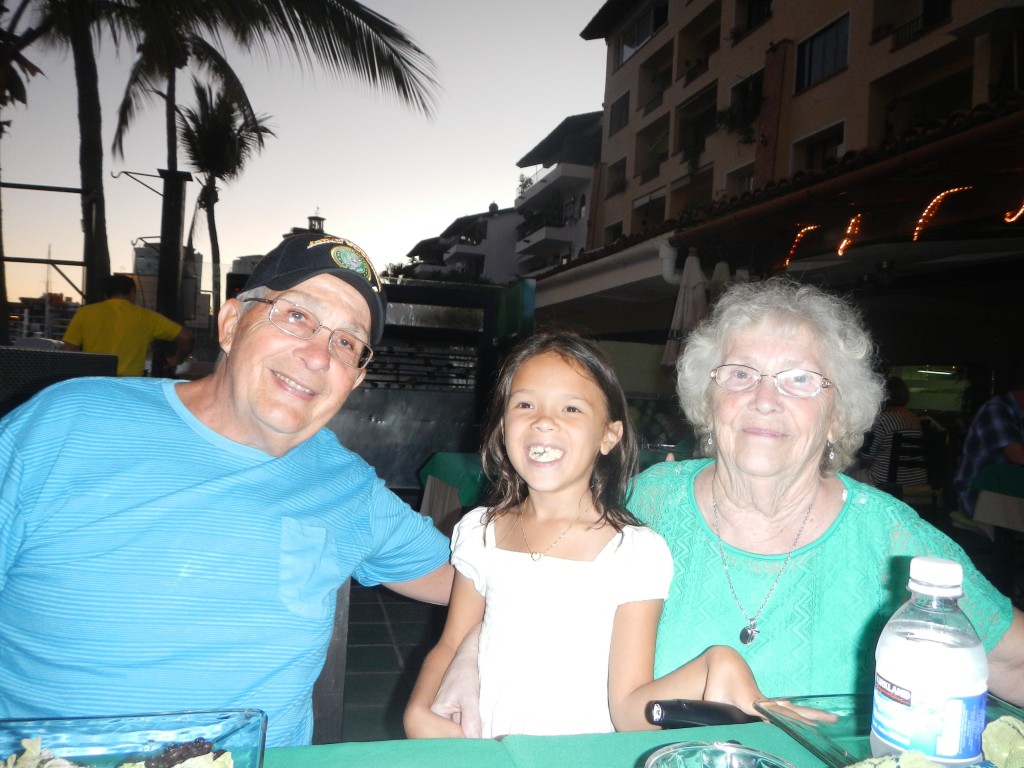
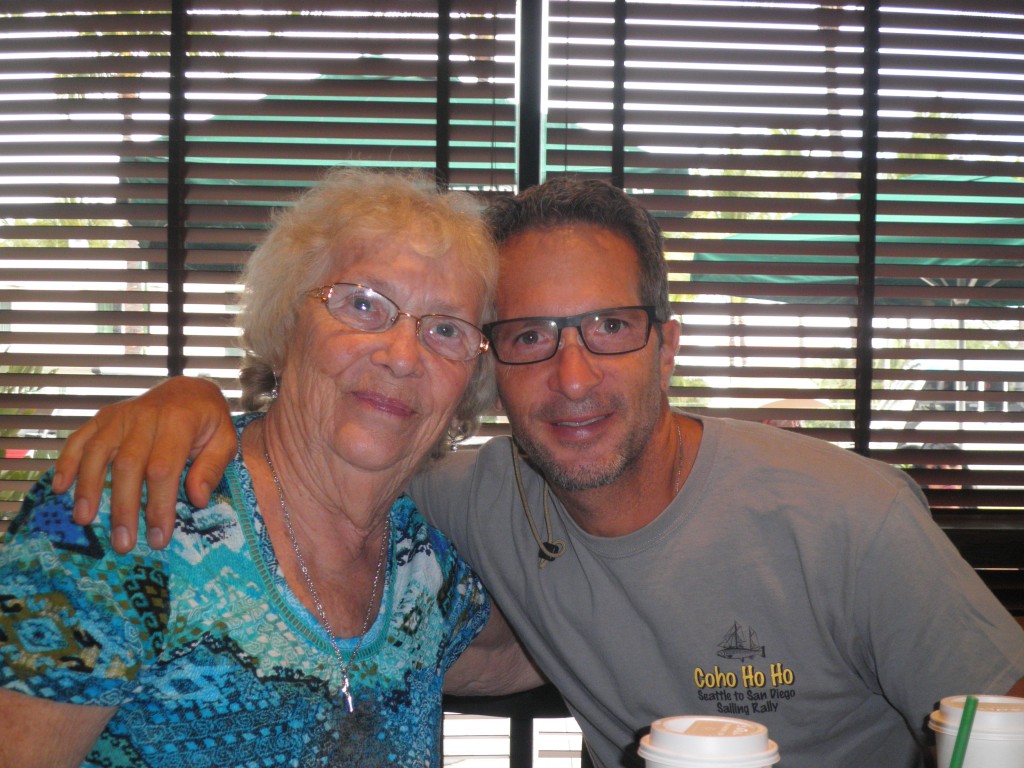
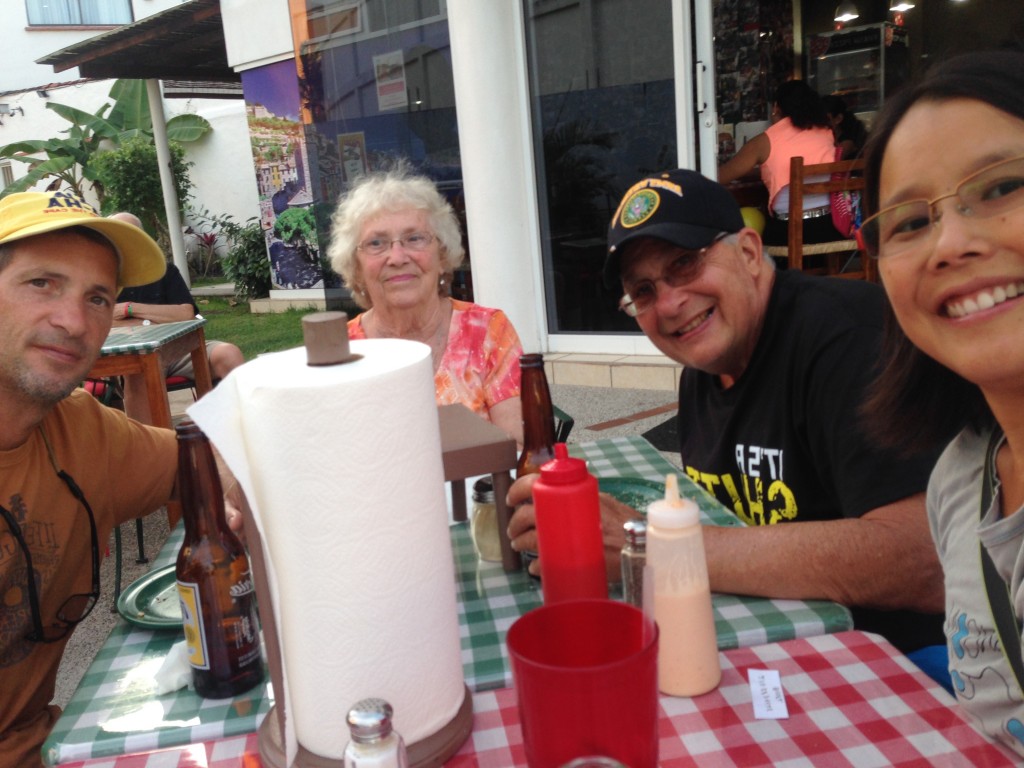
Back to Puerto Vallarta
We departed Ixtapa for the 240 mile trip back to Banderas Bay, making stops at some of our favorite places as well as some new ones.
Manzanillo
After a very long 36 hour motor-sail up the coast to Manzanillo, we anchored in the bay next to the Las Hadas resort, where we relaxed around the pool for 2 more days. This was our favorite stop on our southbound run between Banderas Bay and Zihuatanejo so we were looking forward to spending a few more days there. The beach and resort were set locations for the movie “10” with Bo Derek and Dudley Moore.
Melaque and Barra de Navidad
Since we bypassed this bay on the way down to Zihuataneo, we decided to stop for a few days. The two small towns are at opposite ends of a large bay surrounded by sandy beaches and palapas. An added bonus was that SV Family Circus and SV Pelagic were both going to be there. After dropping the hook, we immediately took the dinghy ashore and met them at a beach-side palapa for drinks. Some highlights of our 3-day stay included a potluck aboard Family Circus, a visit to the French Bakery in Barra, a sleepover for Jacintha aboard Family Circus, roasting and drinking coffee aboard Pelagic, and exploring the small, quaint towns that seem to be like what small US towns were like in the 1970’s. Jacintha was sad to say goodbye to Amaia and Alina but we hope to meet up with them again in the South Pacific.
The next morning SV Ohana pulled into Melaque bay and we met them for a late lunch and a walk through town. Jacintha had a fabulous playdate with Hannah making music videos on the ipad whilst we had drinks and nibblys with Jake and Danielle.
La Manzanilla
Manzanilla (not to be confused with Manzanillo, which is further south), is in the same bay as Tenacatita. It’s at the south-eastern part of the bay and therefore doesn’t offer good protection from the typical winter north-westerlies. Since the wind was coming from the south, plus SV Seahorse V and SV Velvet Sky—both kid boats—were there, so that’s where we ended up! We had a fantastic potluck aboard Seahorse V and Jacintha got to play with Billy, Gracie, and Bucket. Captain Steve had just caught a Dorado that was great tasting along with a bacon-potato dish, fresh guacamole, red wine, and a chocolate cake.
As we are getting closer to our departure date for the South Pacific, we are having to say goodbye to boat friends we have made who are headed in a different direction. This is the case for Seahorse V, Velvet Sky, Ohana, and Pelagic, who are all headed south to Central America and beyond, or for some, spending another season in Mexico. It’s been especially hard for Jacintha to say goodbye to the friends she has made.
Chamela
We had a nice 30 mile sail from Manzanilla to Chamela. A southern 15 knot wind kept us moving at 7 knots the entire way. We brought in a small Skipjack Tuna just outside Manzanilla and a nice Yellowfin Tuna at dusk just before arriving into Chamela so it was an interesting night time anchoring session. Good thing the bay was very wide.
Chamela is a small village with a few tiendas and palapas. The main street is paved but the side-streets are all dirt. The bay is big and offers protection from north-westerlies. When we arrived just near dusk, there was only 1 other boat anchored there. By the following evening there were 10. Chamela is 100 miles south of Puerto Vallarta and is a popular stop because it’s the first good anchorage for boats heading south or the last one for boats headed north. During our 2 days there we rowed the dinghy ashore, played on the beach, and bought some fresh produce at a tienda. Karen and Jacintha swam back to the boat as I rowed the dinghy.
Yelapa
An overnight passage of 90 miles brought us to Yelapa, a funky little village in Banderas Bay about 15 miles southwest of Puerto Vallarta. We decided to stop there for a day before heading to the La Cruz anchorage. It’s surrounded by rugged mountains and has no road access, so people arrive either by boat or horseback. Electricity was brought to Yelapa just 14 years ago. We tied up to a mooring buoy and took a panga to shore where we ate at one of the beach restaurants and bought slices of coconut and lemon meringue pie from the pie lady who walked the beach balancing a basket full of pies on her head.
The highlight of the stop was horseback riding up into the mountains to a waterfall. We thought it was going to be a typical guided tour type ride, and were surprised when they let us go off on our own with two horses—Jacintha and I on a larger one and Karen on her own. The trail crossed a shallow river and meandered up the mountainside past homes and restaurants. The trail was mostly cobblestone and barely wide enough for the occasional 4-wheeler to get by us. It was also very steep and I kept thinking the horse would slip on the wet cobblestones. We were told to go until we reached a church, then turn left. Luckily for us, the horses have been on the trail many times so they knew where to turn! When the horses stopped, we knew we were at the place where the man told us to tie the horses to a pole. Then a short walk and we were at the high cascading waterfall with a pool at the base. The water was a bit cold but we all jumped in and enjoyed the refreshing pool. On the way back, the horse Jacintha and I were on must have been hungry as he galloped most of the way, ignoring any commands of WHOA and pulling back on the bridle. Karen’s horse, on the other hand, stopped to relieve itself and then stopped again at the river for a drink, so they arrived 10 minutes later.
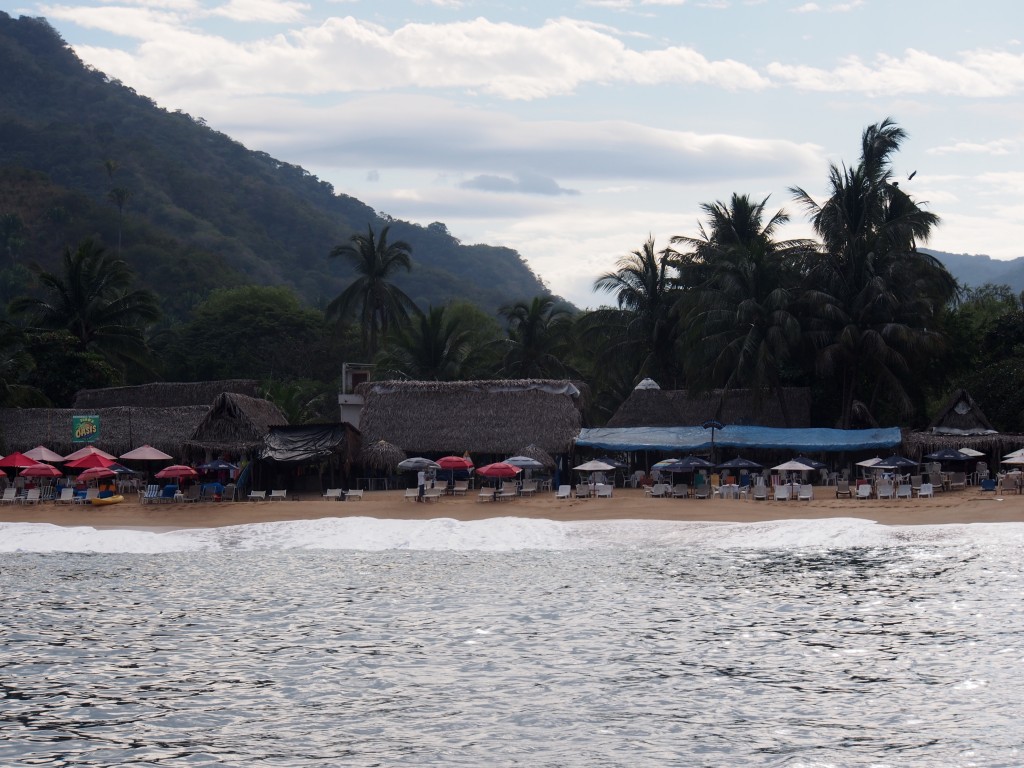
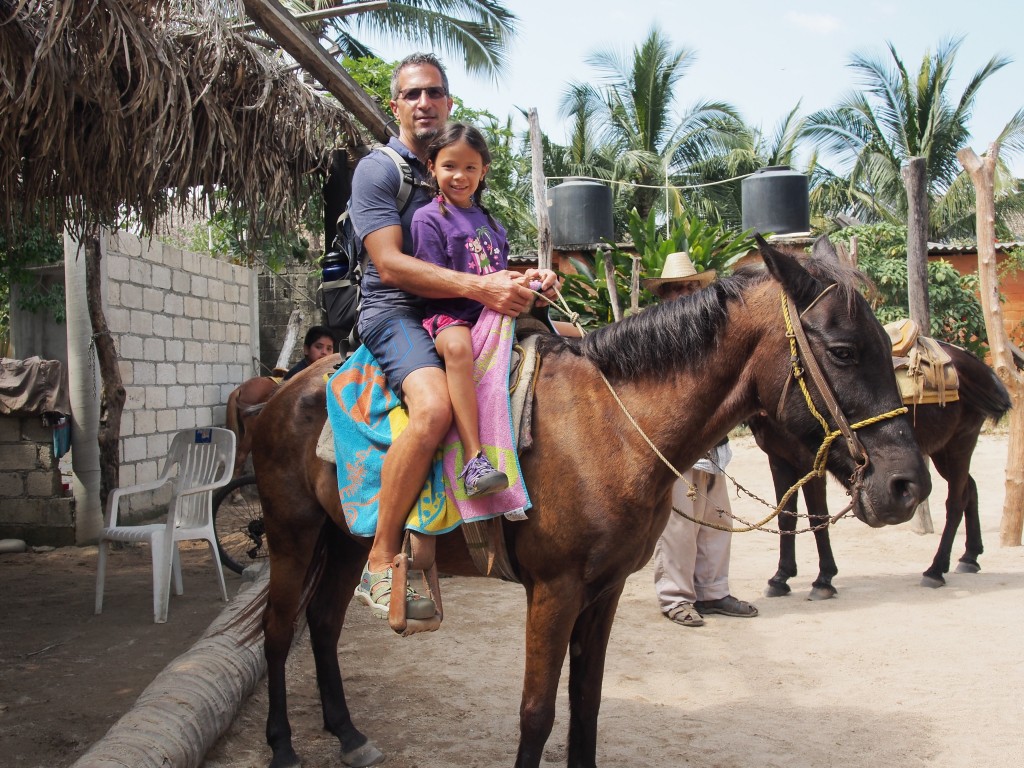
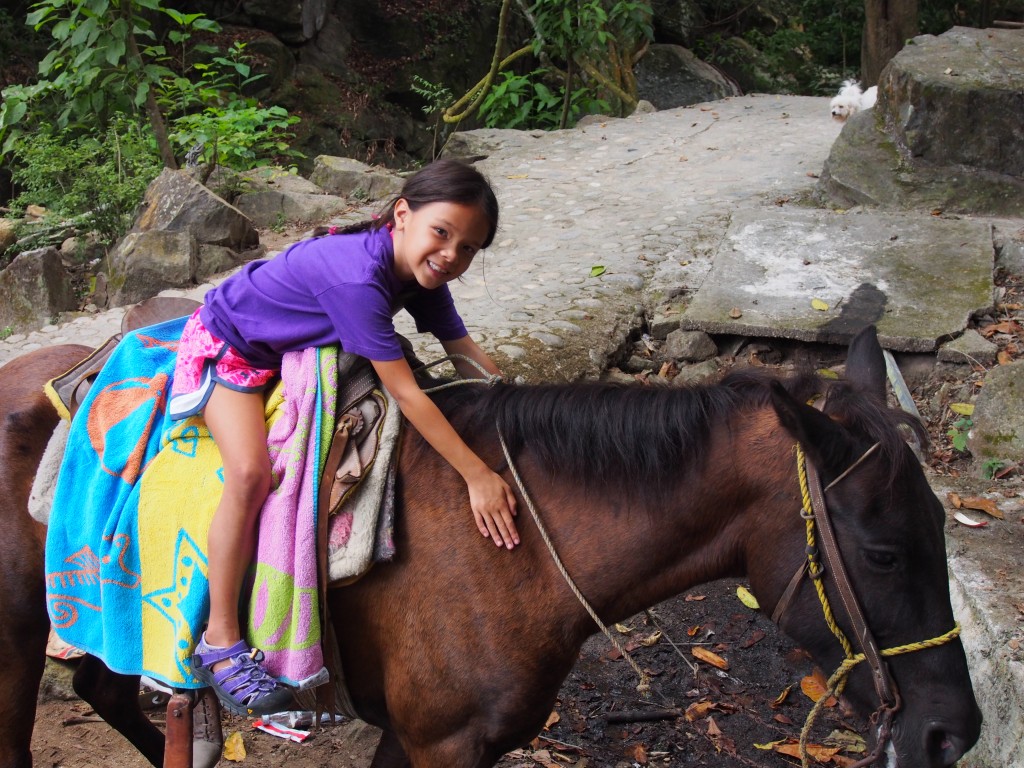
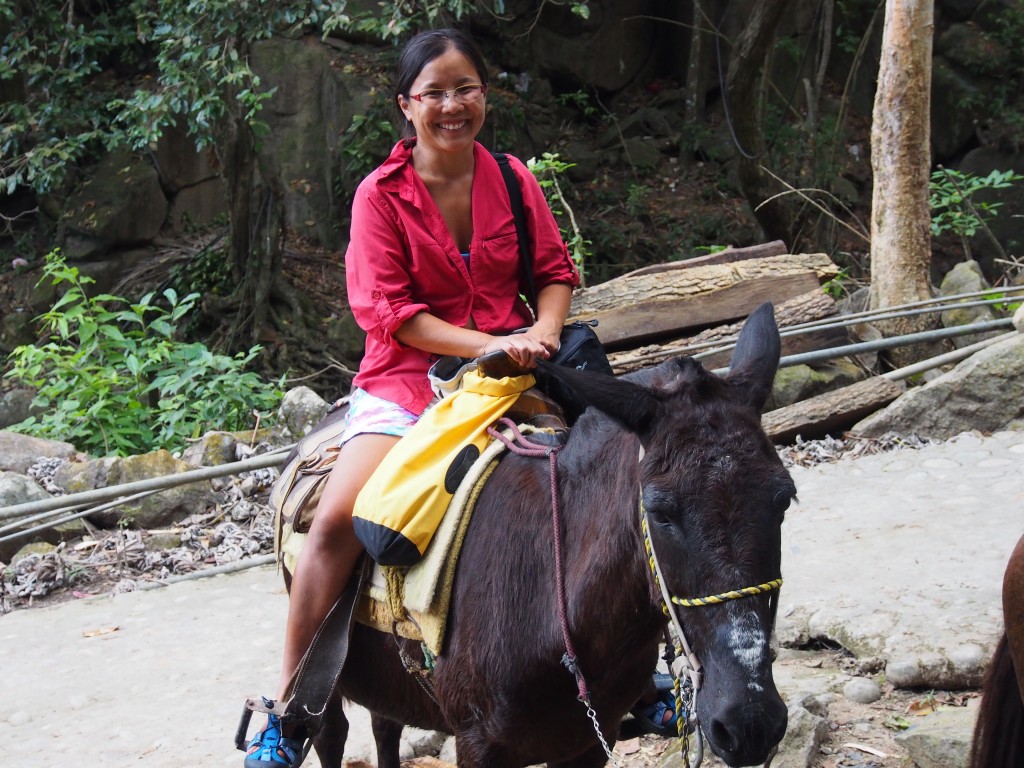
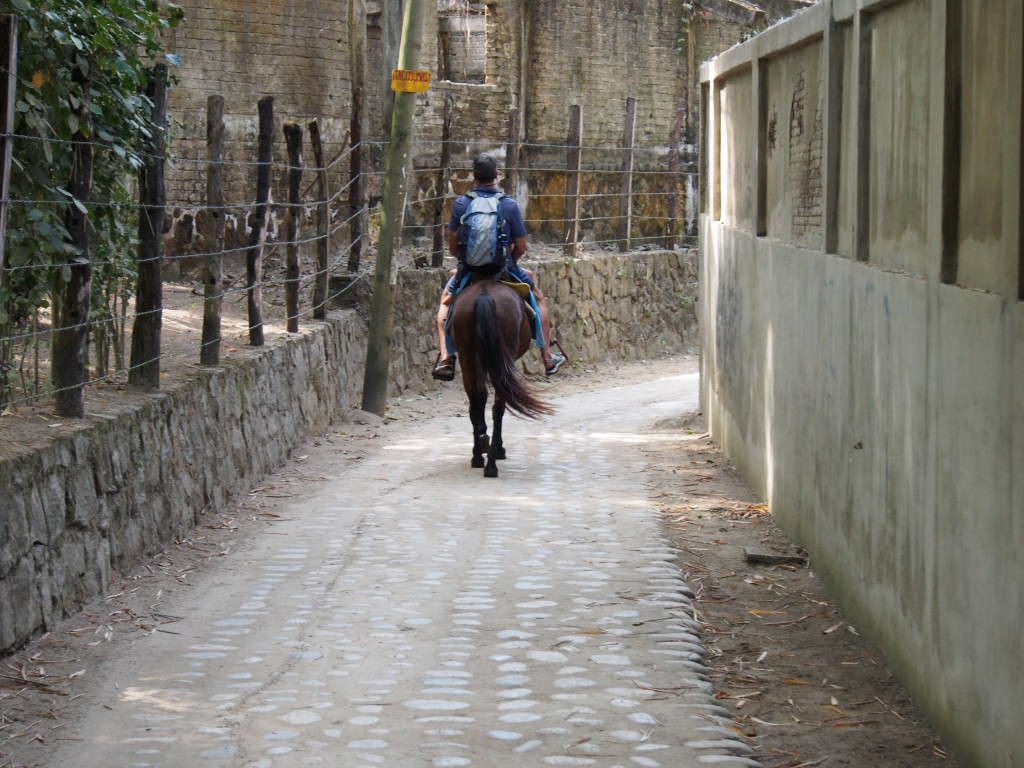
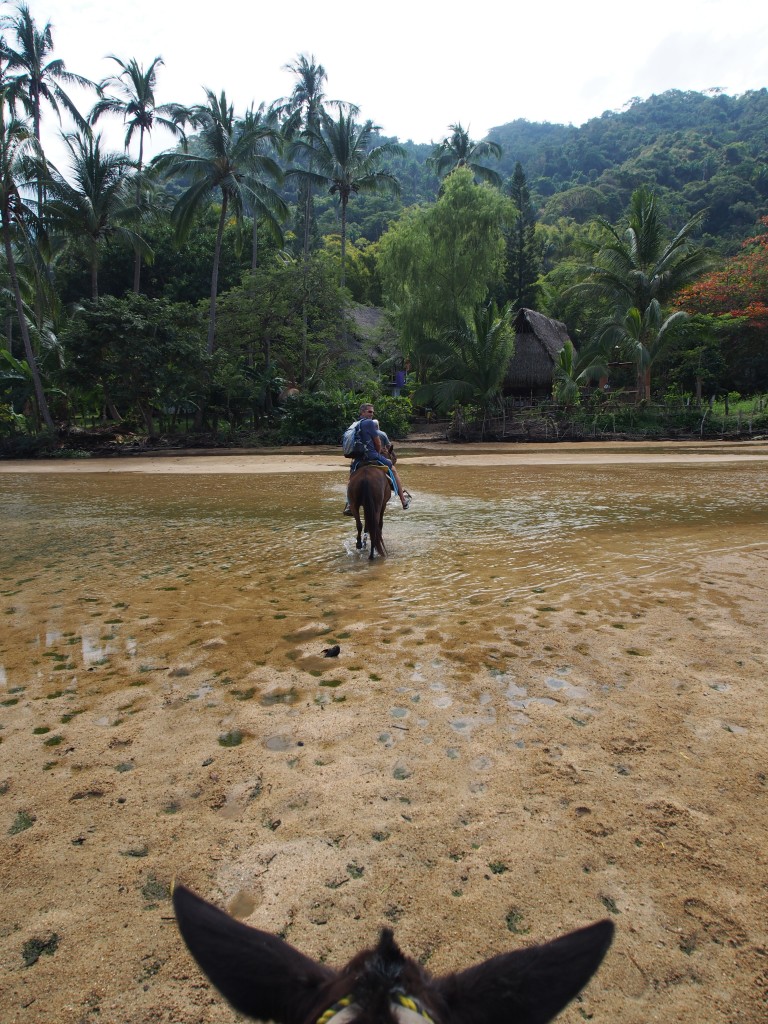
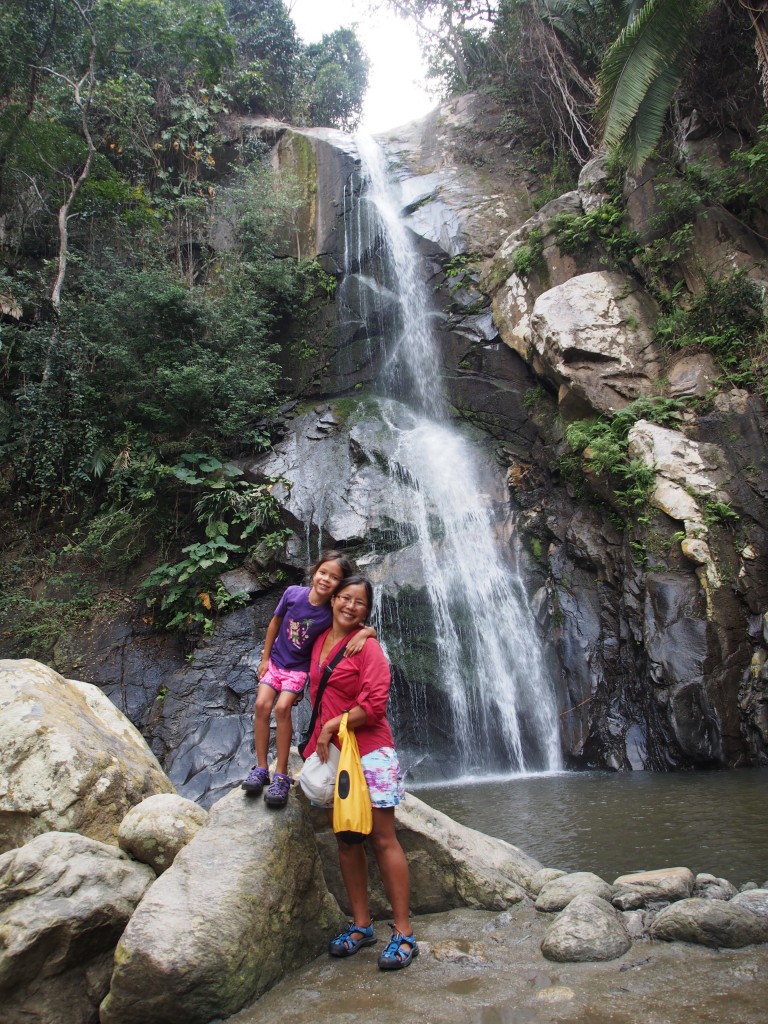
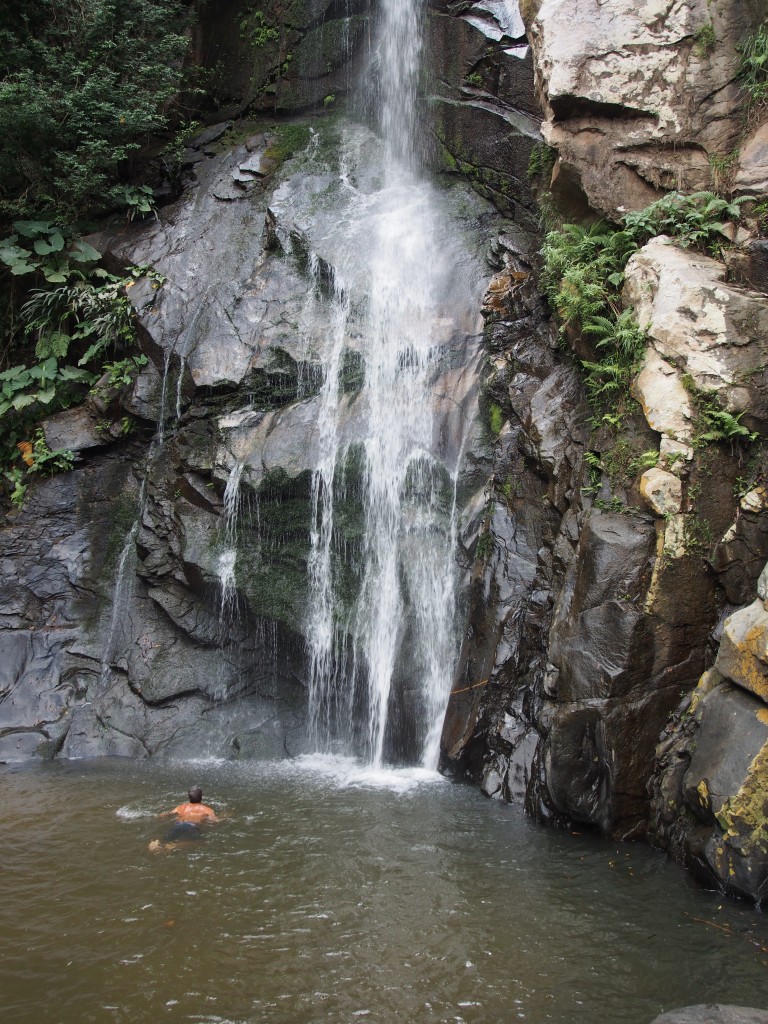
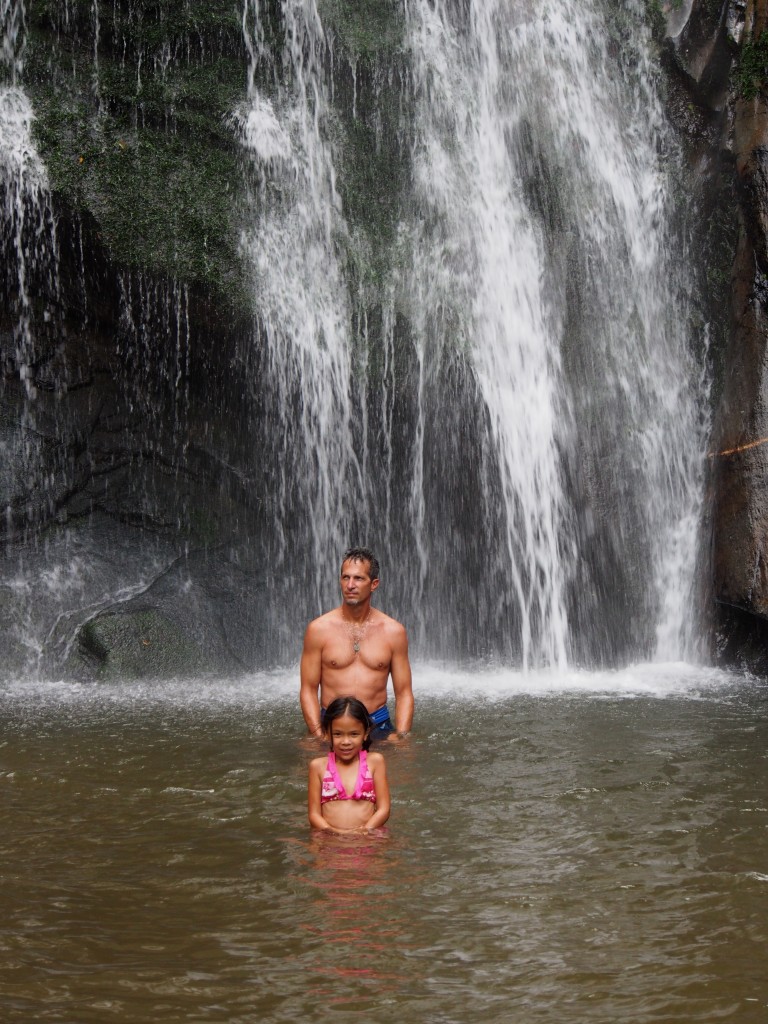
Some boat related things:
- Changed the engine oil & filter in Manzanillo since we’ve been motoring a lot and it was easy to dispense of the used oil at the fuel dock. I normally change the oil every 100 engine hours, but when using the engine so much while cruising (especially in Mexico where winds are light), most cruisers go a couple hundred hours between changes. The last time I changed the oil was in La Paz, 300 engine hours ago—that’s a lot of motoring in 2 months!
- Spent 2 hours using the hookah system to dive under the boat to clean the barnacles off the bottom. The bow thruster cavity and stainless steel thruster props were heavily coated with barnacles since I hadn’t cleaned there before. Other challenging areas were the main propeller and the very bottom of the keel. I also made sure to clean the knot paddle and thru hulls well. The hookah has proven to be invaluable for bottom cleaning as well as replacing zincs and dealing with fouled props. We hope to use if for shallow recreation dives in the south pacific.
- Dug out the shade cover for the boat and found it makes a huge difference in keeping the boat cooler during the day. The cover came with the boat but we improved it by buying custom-made, collapsible fiberglass poles (just like tent poles) and sewed pockets into the cover. We moved the solar panels onto the bowsprit so they still get the full sun.
- Karen worked on making some canvas cockpit pockets. The cockpit always seems to be littered with small things such as iPhones, iPads, Kindles, hose nozzle, deck plate wrench, sail ties, snacks, and so forth. The dodger has 2 small built-in pockets that are always full. The new pocket will be large enough to fit an iPad, which we use for navigation, and will attach to the weather cloth.
